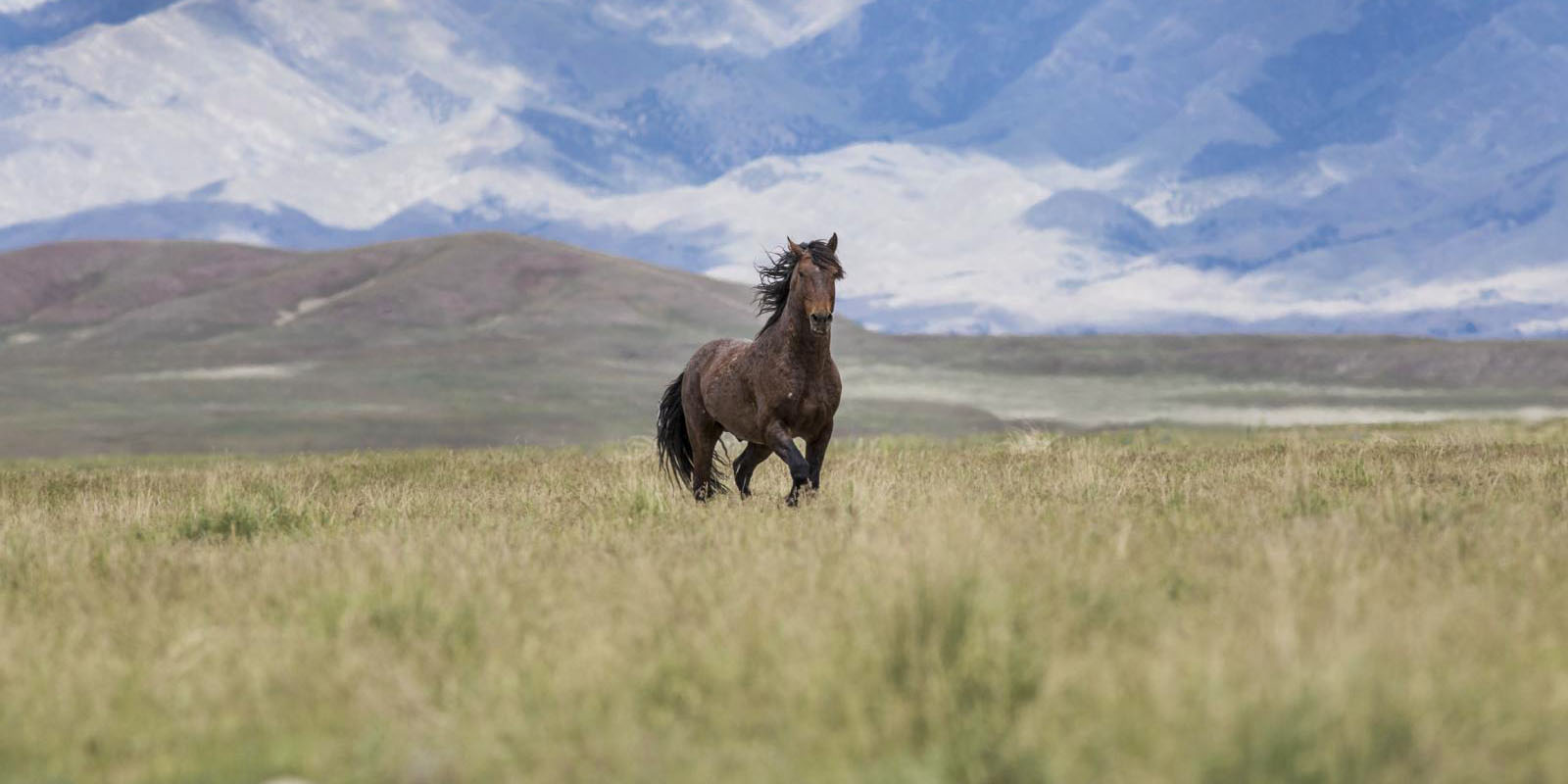On December 28, 2023, the Bureau of Land Management (BLM) began a wild horse helicopter roundup in the East Pershing Complex located in northwestern Nevada. The complex is composed of 3 HMAs (Augusta Mountains HMA, North Stillwater HMA, and Tobin Range HMA) and 4 HAs (Augusta Mountains HA, East Range HA, Humboldt HA, Sonoma Range HA) and contains a mixture of public and private land. It crosses three BLM districts: Winnemucca, Carson City, and Battle Mountain. The contractor for this operation is Sampson Livestock who was awarded $690K in taxpayer funds. BLM’s target removal number is 2,875 horses. The press release indicated there would be no use of fertility control to suppress population numbers. Horses removed from the range will be transported to the Winnemucca Off-Range Corrals in Paradise Valley, Nevada, for preparation for adoption or sale.
AWHC has observers onsite to document the operation.
Roundup Report
Roundup: East Pershing Complex FY 2024
Date: February 7, 2024
Location: Near Daisy Mountain in Battle Mountain, NV (same as 6th)
Weather Conditions:
- 32°F
- Mostly grey skies
- Occasional sun
- Occasional snow
- Fog rolling in and out
Summary:
Trap visibility was poor to nonexistent today. Of the 10 runs made today, only 3 were visible from the observation site. One horse escaped in the late afternoon. Operations will continue at the same trap tomorrow.
Total Captured Today (from BLM reports):
80 (27 stallions, 41 mares, and 12 foals)
Observations and Events:
- 6:30 AM: Departed from the BLM office at Battle Mountain
- There were lots of cows on the drive out
- 7:30 AM: Arrived at the observation site
- Site is ~1 mile from the trap
o There is no visibility of the wings
o The wings are inside a depression and horses cannot be seen or counted when entering
o There is partial visibility of one wall of the corral if no trailers are parked in front of it - Horses were grazing with the cattle near observation
o They left as the vehicles got close - 8:30 AM: Saw the helicopter
- 8:40 AM: The first run of horses is suspected to have been brought in
o No horses can be seen - 8:50 AM: Witnessed the helicopter entering the trap, but there is no visibility of the horses
- 8:56 AM: Another presumed run, but no visibility
- 9:00 AM: A trailer leaves the trap site
o It left the trap site, drove 500 yards away and then met another truck and ATV
o The trailer remained there a few minutes and then drove away - 9:10 AM: Helicopter appears to have driven run 4 into the trap, but no horses are visible
- 9:22 AM: ~10 horses are brought in from the opposite side of the trap
- 9:28 AM: A second trailer departs
- 10:25 AM: The 6th run, ~12 horses
- 10:50 AM: Horses were seen only briefly before disappearing
- 11:15 AM: The 8th run comes from the non-visibile side
- 12:30 PM: The fourth trailer leaves the trap site
- 12:45 PM: 9th run; horses are not visible
- 12:50 PM: Helicopter lands at the trap site
- 12:56 PM: Helicopter takes off
- 2:45 PM: The helicopter is visible again after being gone for almost 2 hours
- 3:00 PM: The 10th and final run of the day with around a dozen horses
o One of the horses breaks off and goes towards the observation site
o The horse stops outside the cattle fencing near observation
o The horse looks towards the trap site, before running into the hills opposite observation - 3:10 PM: Operations end for the day
Temporary Holding:
Located on private land in Antelope Valley. Observers are not allowed to visit.

Cattle graze near the trap site while active helicopter operations are underway.


Four horses being driven towards the trap.


The view of the trap site from observation. Parked trailers prevent view of much of the trap. Topography obscures views of the wings and horses coming into the trap.

Captured horses in the catch pen at the trap site.

A larger group which came from a direction visible from observation.

Another of the groups visible today.

A loaded trailer headed towards temporary holding. Holding is on private land and cannot be visited.

One horse broke away from the final run of horses. They looked back towards the trap site before running into the hills.
Date: February 6, 2024
Location: Battle Mountain, NV
Weather Conditions:
- 36°F
- Misty
- High humidity
- Turned to snow and heavy fog
Summary:
Operations were suspended today due to decreased visibility in foggy weather. Onsite observers included students from Oregon State University. As the students were only present for a single day, they were given a full tour of the new trap site and other observers were asked if they would like to join. AWHC’s observer was allowed to walk back through the trap at the end of the tour to take a short video. The trap was not fully finished by the tour, so it was difficult to determine adherence of its construction CAWP standards.
Temporary Holding:
On the tour, the BLM mentioned that Antelope Valley had been used as a temporary holding site for the last two days (since February 4th). Onsite observers had not been told about this change (previously, horses were being routed directly to Paradise) until today. Thusfar, observers have not been able or allowed to visit temporary holding in Antelope Valley.
Join AWHC’s onsite observer for a tour of the trap site.
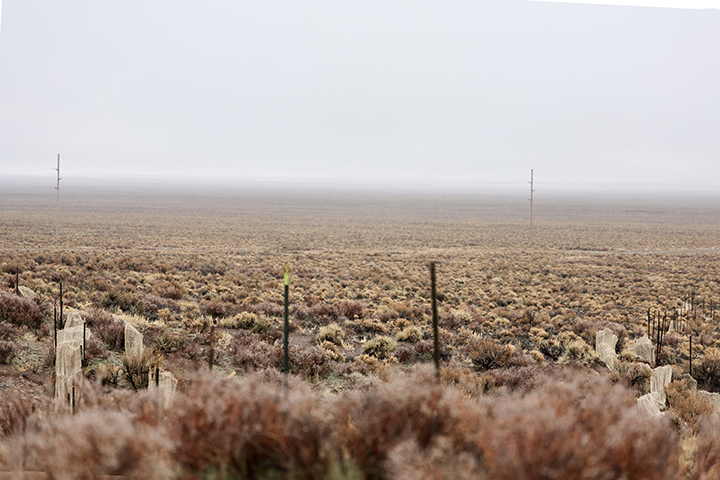
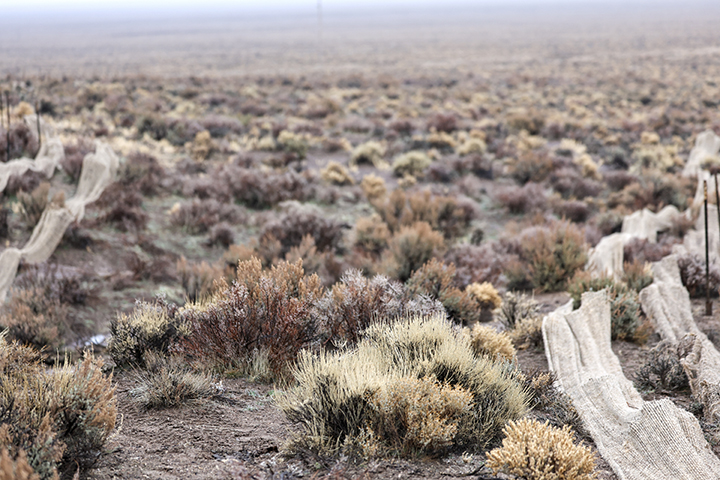
The wings of the trap opening out into the valley. The jute fabric of the wings is currently on the ground, but would be placed on the posts during operations. The wings widen outward the further the distance of the trap in order to funnel the horses towards the trap.
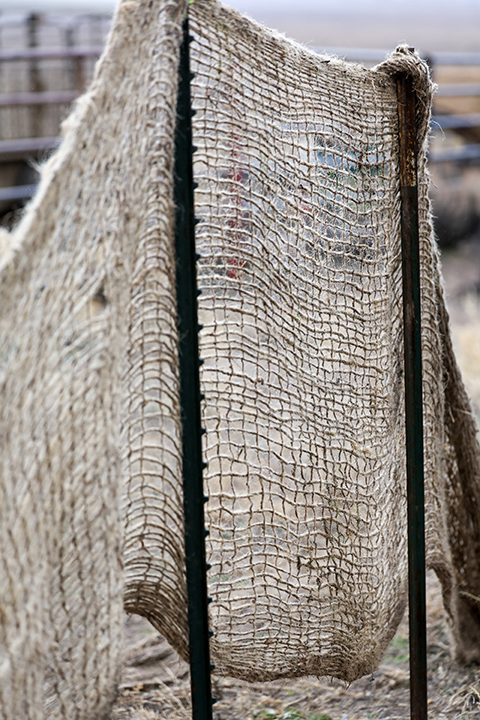
Jute fabric which is used in the wings.
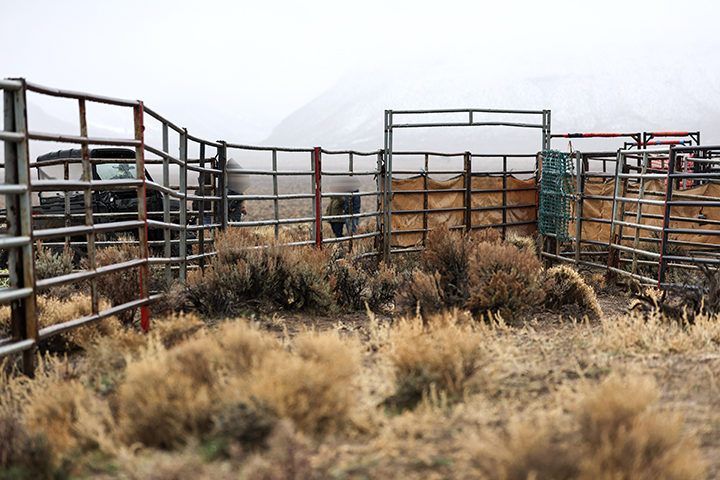
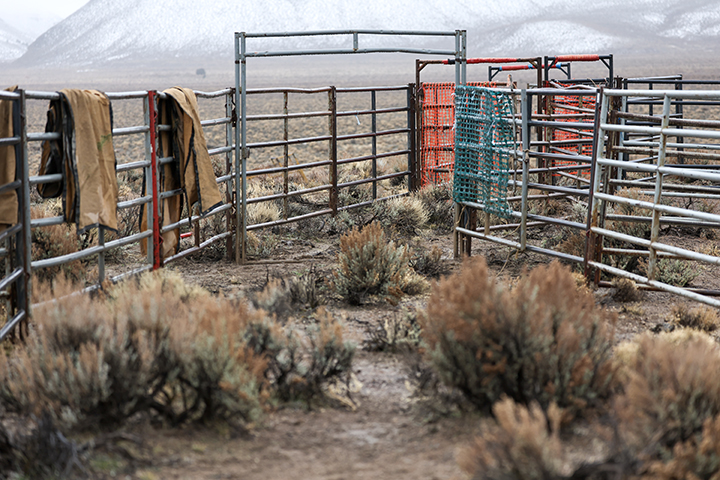
The entrance to the holding part of the trap. The area in front of the gate with green fabric is the first area that the horses run into.
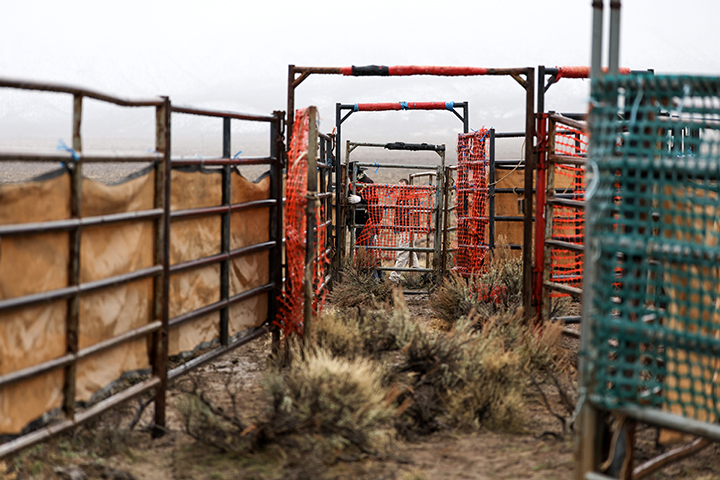
The trap becomes progressively smaller until it is a single-file alley. Gates are placed along these alleyways which can be open or closed for use in sorting.
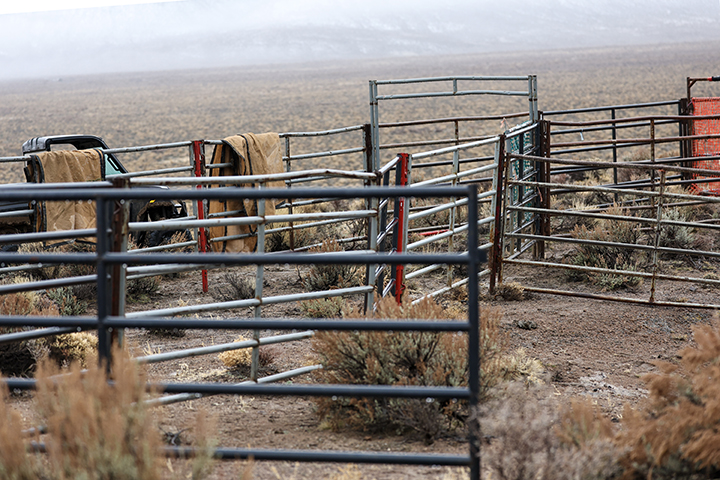
Extra fencing. These fencing panels can be added to the end of the other panels in order to make the trap size larger.
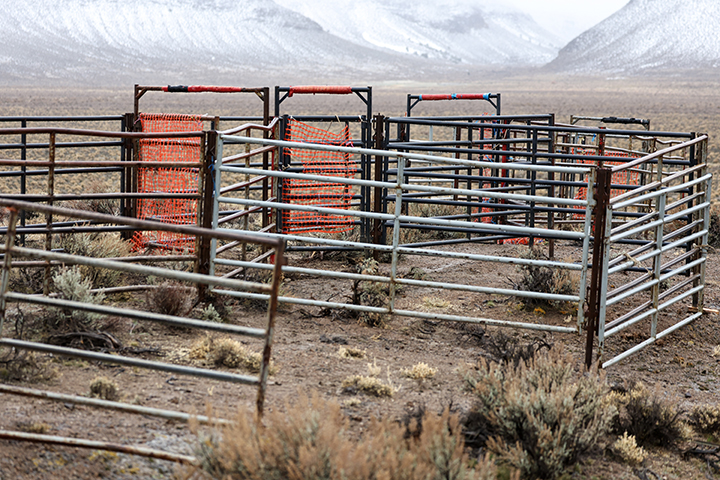
The foal pen. Foals are sorted here prior to loading. The very last padded bar on the right is the final gate of the trap, where horses pass through before loading into trailers.
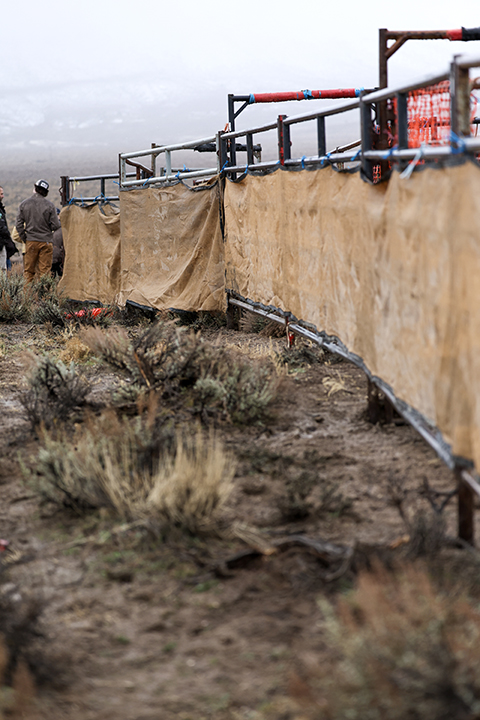
A view looking back towards the trailer loading area from the beginning of the single-file aisleways of the trap. BLM’s CAWP guidelines state that, “All gates and panels in the animal holding and handling pens and alleys of the trap site must be covered with materials such as plywood, snow fence, tarps, burlap, etc. approximately 48” in height to provide a visual barrier for the animals. All materials must be secured in place.”
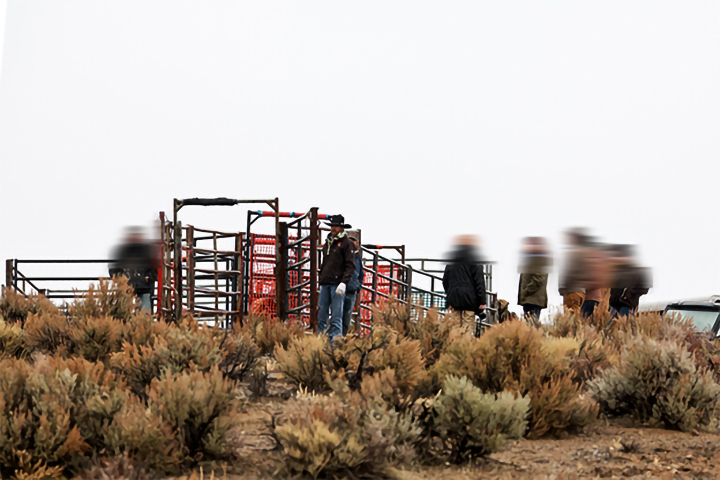
The back of the trap. Trailers would be backed up to the opening next to the Bureau of Land Management employee.
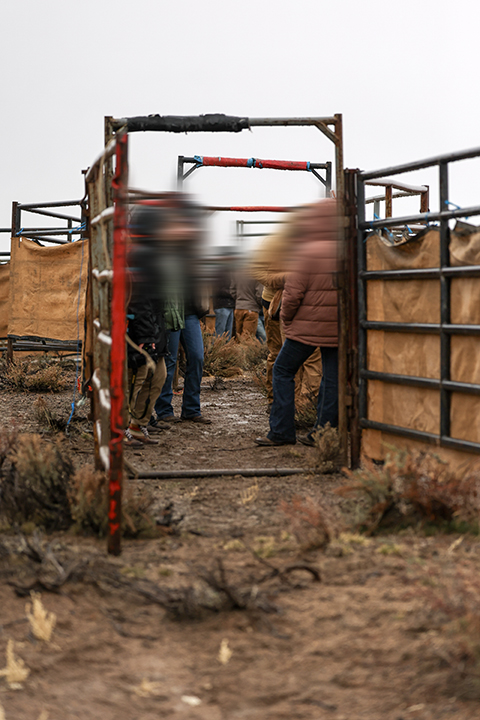
A closer view of the panels which create a passage between the back gate of the trap and the back of the trailer which is backed into the trap site for loading.
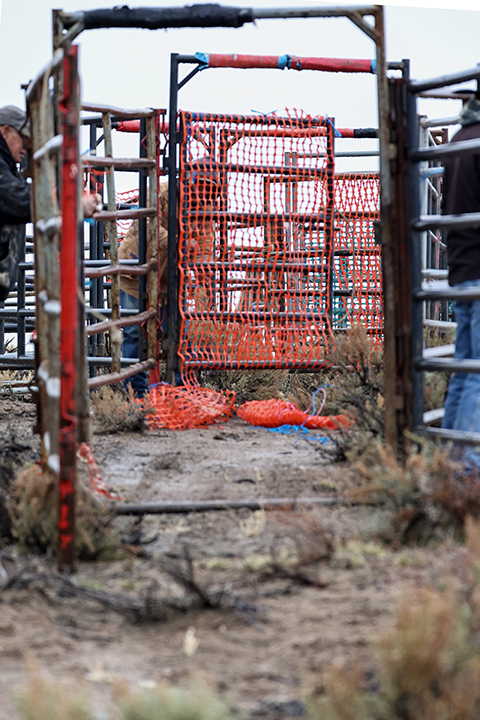
Looking through the final gate at the back of the trap. Horses must pass through this before loading into trailers.
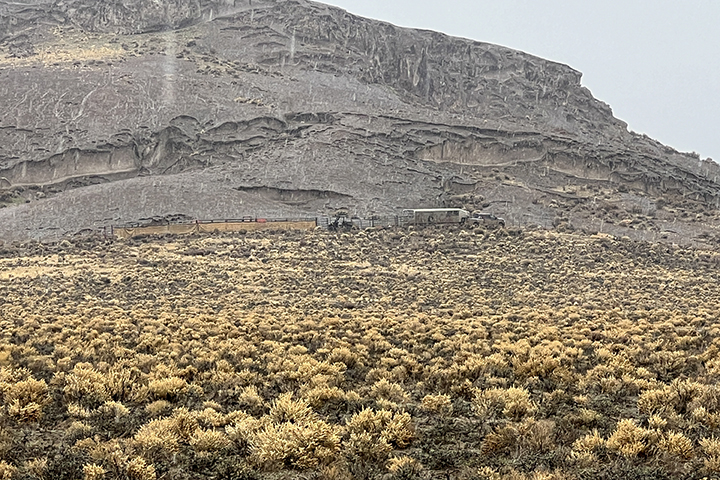
The trap site as visible from observation. Loading of horses into trailers occurs on the right. Horses enter the trap from the left-hand side. Topography obscures the wings themselves and the entrance to the trap.
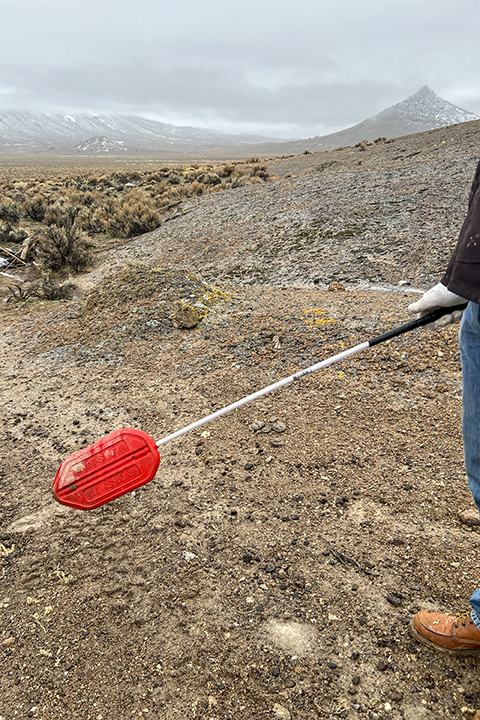
A rattle paddle. Material inside of the paddle moves as the paddle is shaken, making noise. The paddle can be used to push horses forwards or backwards.
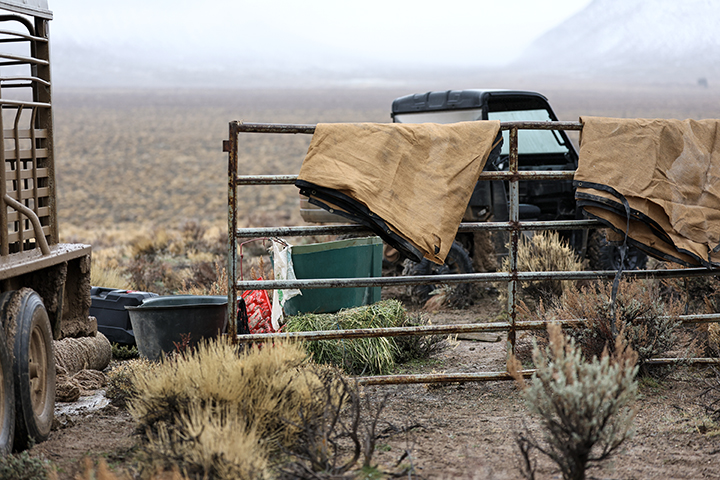
Hay, water troughs, and tarps hanging over fencing at the trap site.
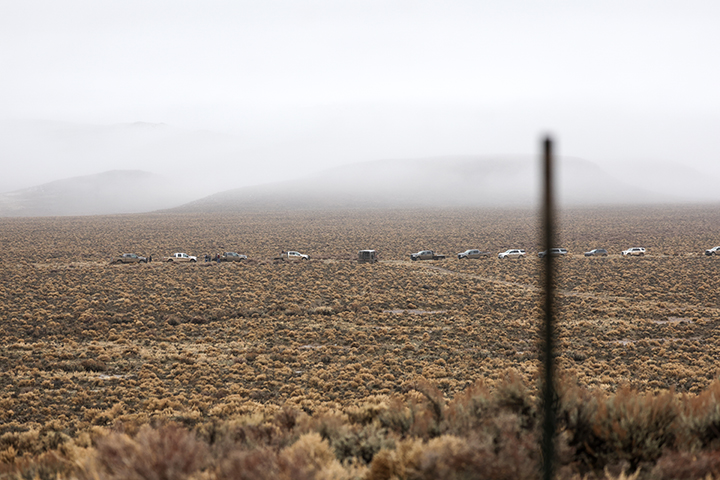
The view out of one of the trap wings towards observation.
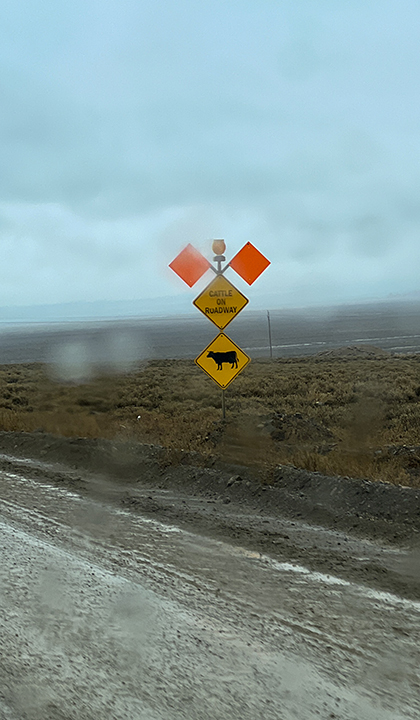
Various signs warning of cattle crossing seen on the roadways today.
Date: February 4, 2024
Location: Jersey Valley, NV (same as the 2nd and 3rd)
Weather Conditions:
- 34°F
- Grey
- Snowing Heavily
- Foggy
Summary:
There were 5 runs of horses between the morning and early afternoon. Operations have been at the same trap site for the last 3 days. A hill blocks the majority of the trap, obscuring independent assessment of the trap by AWHC. Heavy snows began in the early afternoon, haltering operations for the day. All horses captured are being taken directly to Paradise Valley Off-Range Corrals, which is closed to the public.
Total Captured Today (from BLM reports):
84 (28 stallions, 35 mares, and 21 foals)
The BLM euthanized 1 horse for a chronic condition:
- 20+ year old sorrel stallion; euthanized due to blindness and a missing right eye
Observations and Events:
- 8:20 AM: Arrived at observation
- 9:10 AM: Run 1 of approximately 17 horses
o Run includes two yearlings/weanlings and a young foal
o Foal entered trap next to its presumed dam - 9:16 AM: Run 2 with 7 horses and one young foal, which entered the trap close to its presumed dam
- 9:40 AM: Approximately 9 horses in run 3 enter the trap
- 10:50 AM: Around 16 horses are captured
o Group includes two horses estimated at 1-2 years of age - 12:50 PM: Run 5, composed of ~19 horses
- 1:15 PM: Livestock trailers went to the livestock semis to transfer horses
- Two trailers were unloaded into a single livestock semi
- 1:30 PM: The livestock semi leaves for Paradise Valley
- 1:40 PM: Heavy snow
- 1:54 PM: 3 loaded trailers come down from the trap to a waiting livestock semi
o Visibility is very low due to snow - 1:55 PM: The gather operations are stopped for the day


The trap site. The first photo shows the view from observation. The second photo is a zoomed in look using camera equipment, showing the hill blocking visibility of the trap. The distance and the topography prevent independent assessment of the trap site for adherence to CAWP policy.






There were 5 runs of horses captured today, with young foals present in a few of the groups brought into the trap by helicopter.
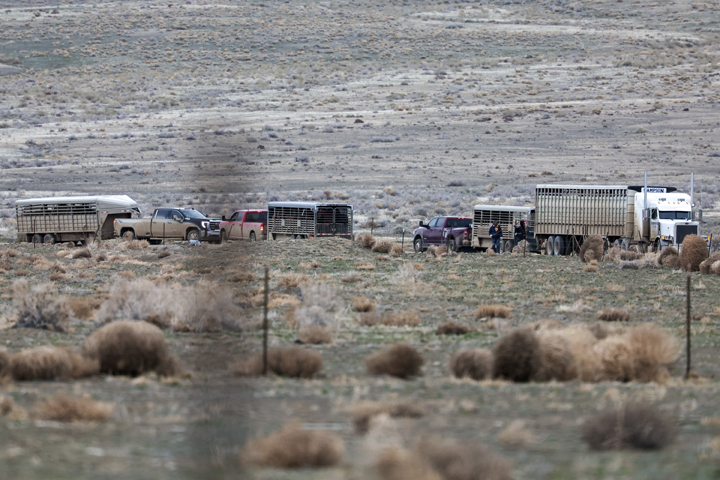


Trailers loaded up the hill at the trap site are brought to livestock semis. Captured horses are transferred to the semis and then taken to Paradise Valley Off-Range Corrals. These corrals are closed to the public.
Date: February 3, 2024
Location: Jersey Valley, NV (same as the 2nd)
Weather Conditions:
- 34°F
- Sunny
Summary:
Today’s roundup was at the base of the Augusta Range. There is unmarked barbed wire fencing in this area, but there have been no issues thus far. Six runs of horses came in today with no incidents seen. However, the observation point is ~1.5 miles from the trap and the trap is obscured by topography.
Total Captured Today (from BLM reports):
146 (56 Stallions, 69 Mares, and 21 Foals)
Observations and Events:
- 8:15 AM: Arrival at observation
- Roundup operations are at the base of the Augusta Range along the road
- There is a lot of fencing in this area
o None of the fencing is marked
o No issues seen thusfar with horses being navigated through the opening - 9:30 AM: A group of 10 horses
- 10:10 AM: A group of ~19 horses
- 10:32 AM: The first trailer load of horses leaves to transfer captured horses to the livestock semis
- 10:40 AM: The fourth run comes in, with ~11 horses
- 10:44 AM: Three horses that had been part of the larger group in the 3rd run are brought into the trap
- 11:00 AM: The second trailer load went to the livestock semi
- 11:10 AM: The third trailer goes to the livestock semi
- 11:11 AM: First livestock semi departs
- 11:20 AM: The fifth run comes in consisting of approximately 30 horses
o These horses broke into two groups: one of eight and one group of around 22
o Both subgroups were brought into the trap - 11:45 AM: The sixth run of around 30 horses
- 2:00 PM: The fourth trailer load of horses goes to the livestock semi
- 12:20 PM: The second livestock semi departs for Paradise Valley Off-Range Corrals
- 2:15 PM: Roundup operations end
- The final loads of captured horses were loaded after observers had left
- Onsite observers were denied when they asked to see the trap area




Horses being driven towards the trap. There were six runs today with no incidents to report.

Background: The trap, not visible as it is obscured by a hillside, and livestock trucks waiting to load captured horses.
Midground: A group of horses being driven to the trap by helicopter
Foreground: A livestock semi waiting for horses to be transported to the Paradise Valley Off-Range Corrals

Horses being transferred from livestock trailers to livestock semis. Sorting is being done directly at the trap site and livestock semis are going to the Paradise Valley Off-Range Corrals.

Livestock semi.
Date: February 2, 2024
Location: Jersey Valley, NV
Weather Conditions:
- 35°F–39°F
- Sunny
Summary:
There were 11 runs of horses today. A few horses broke off from a larger group and were later brought in by the helicopter. One horse, a mare, was roped and brought in to the trap by two wranglers. Runs appeared to go smoothly, with no injuries or incidents seen or reported by the BLM. Horses are being taken directly to the Paradise Valley Off-Range Corral.
Total Captured Today (according to BLM reports):
71 (22 Stallions, 42 Mares, and 7 Foals)
Observations and Events:
- 7:50 AM: Arrived at the trap site
- The trap is ~1.5 miles away from observation
- Views are of:
o the two wings which were extended and widened today
o a portion of the trailer - There is no visibility of the trap itself
- 8:45 AM: ~13 horses are brought in
- 9:30 AM: ~10 horses
- 10:20 AM: ~15 horses and this group contained a weanling or yearling
o This horse took about 30 minutes to get into the wings
o The yearling kept up with the other horses - 11:20 AM: The fourth run, ~10 horses
- 11:50 AM: 3 horses
- 1:21 PM: ~6 horses
o These horses ran for just over 30 minutes and did appear damp
o Horses looked steady as they entered the trap wings - Just after the previous run, the pilot gathers up 4 horses that had broken off from the previous run
- 1:51 PM: A single female that had gotten away is targeted by the helicopter
o Two saddle horses and riders roped this horse
o The roping was not visible
o When the horse re-appeared, she and the saddle horses appeared calm - 2:00 PM: The ninth run of horses comes in
- 3:05 PM: ~ 9 horses are trapped
- 3:15 PM: Two horses are brought in
- 3:15 PM: Roundup operations ended for the day
Temporary Holding:
There is no temporary holding. Horses are offloaded from trailers loaded at the trap to livestock semis. These horses are taken directly to the Paradise Valley Off-Range Corral.



There were 11 runs of horses brought in by helicopter today with no injuries or deaths to report.


A single mare got away from the helicopter during one of the runs. She was pursued by helicopter, then by two wranglers and roped out of site. There did not appear to be any incidents as she was brought back to the trap.

Captured horses are transferred from trailers loaded at the trap to livestock semis. They are headed to the Paradise Valley Off-Range Corrals with no temporary holding in between.
Date: January 31, 2024
Location: Intersection of Sou Hills Rd. & Dixie Valley Rd., NV
Weather Conditions:
- 41°F–55°F
- Overcast
- Rain Showers
Summary:
Horses came in sporadically throughout the day today, suggesting that the pilot had trouble finding horses. Observation offers unobstructed views of the trap from only ½ mile away. Sorting of horses was done at the trap. There were no injuries or deaths seen by AWHC’s observer or reported by BLM today.
Total Captured Today (from BLM reports):
57 (21 stallions, 26 mares, and 10 foals)
Observations and Events:
- 6:30 AM: Met with BLM personnel and caravanned to the trap site
- Observation is ½ mile or less from the observation site
o There are no obstructions to the view of the trap
o Can see the wing, alley, catch pen, and loading - Horses came in sporadically with quite a bit of time between runs
o This often means the pilot is having trouble finding horses - Horses were sorted directly at the trap
o When horses are sorted at the trap, they are typically on trailers for longer - 9:15 AM: ~5 horses are brought in
- 9:36 AM: Horses were loaded
- 11:20 AM: The second run came in of ~15 horses
- 11:30 AM: Pilot refuels
- 11:45 AM: 4 horses are trapped
- 1:30 PM: 10 horses are trapped
- There was one more run, then operations ended for the day
A sequence from Run 3 today, showing a clear view of roundup operations from the helicopter navigating horses to the trap to loading horses.
A livestock trailer loaded with horses leaving the trap site.
Date: January 29, 2024
Location: ~60 miles south of Battle Mountain (same as 21st, 22nd, 29th)
Weather Conditions:
- 36°F–58°F
- Sunny during operations
Summary:
Upon entering the trap, a group of 4 horses spooked in the alleyway. Three escaped the trap wings, resulting in one mare being roped and hog-tied. Two of these horses escaped. Operations for the day were short as it was a cleanup day and the last day at this trap location. The trap will be moved for tomorrow.
Total Captured Today (from BLM reports):
7 (3 stallions, 4 mares, and 0 foals)
Observations and Events:
- 6:30 AM: Met at the BLM office in Battle Mountain
- Two members of the public, including AWHC were in attendance
- 9:00 AM: A group of 4 horses are navigated to the trap
o The horses spooked in the alleyway of the trap
o 3 of the 4 horses either turned around or went through the jute
o The horses ran back towards the mountains - A wrangler went out after the escaped horses
o This wrangler successfully roped the mare
o Another wrangler went out to join him
o They took the roped mare down the ravine - The helicopter went out in pursuit of the remaining 2 horses
- After 30 minutes, they stopped as they were unable to catch them
- The helicopter landed
- Wranglers attempt to bring in the roped mare
o The mare bucks a few times and falls to the ground
o The wranglers hog-tied the mare and then left her on the ground
o They came back with a trailer to load her
o She was pulled into the trailer on a sled
o When asked, the BLM indicated that the mare was fine - The day was short as it was a cleanup day and the trap was moved after helicopter operations ended
- BLM listed average body condition as 3 to 5
A mare who escaped from the trap is roped, hog-tied, and then pulled into a trailer. Photos of the sequence can be seen below.
Four horses that were brought into the trap. When they entered the trap, something spooked them in the alleyway and 3 of the horses ran out of the trap. Of these, 2 escaped, and one mare was roped.
A wrangler from the trap site rides out on horseback to rope the escaped mare. The helicopter heads to try and retrieve the remained two escaped horses.
The two horses who eventually escaped, being pursued by helicopter.
The final running horse, a mare, was hog-tied after she was roped.
After being hog-tied, the roped mare was left unattended until a trailer was brought to her position. She was then pulled into the trailer.
Roundup: East Pershing Complex FY 2024
Date: January 28, 2024
Location: ~60 miles south of Battle Mountain (same as 21st, 22nd)
Weather Conditions:
- 34°F–55°F
- Partly cloudy to sunny throughout the day
Summary:
Operations returned to the same location as on the 21st and 22nd of January. Observation is close to the trap, at around ½ mile away. There was a lot of activity in the morning as contractors were taking down fencing. Six total runs of horses were brought in today. Horses had to be navigated through existing fencing. However, this fencing was unmarked and in one of the runs, a horse went through barbed wire and fell. No actions were taken to make the fence more visible after this event. Temporary holding still cannot be visited to assess conditions or injuries as it is on private land.
Total Captured Today (from BLM reports):
81 (39 stallions, 31 mares, and 11 foals)
Number of Horses Captured in the Roundup Thusfar (as of the 28th):
2,042 (851 stallions, 931 mares, and 260 foals)
Observations and Events:
- 6:45 AM: Met with BLM personnel and travelled 60 miles south of Battle Mountain
- Roads were wet and muddy
o Contractors had to take alternate routes along parts of the road to the trap in order to avoid being stuck
o Trucks were getting stuck in the mud at the loading area and needed to be pulled out
o At one point, a trailer loaded with horses sat for over an hour - Observation site is ½ mile from the trap and is the same location as on the 21st and 22nd
- Prior to being setup at observation, 4 horses ran by
- Contractors were taking down fencing
- None of the fencing horses were ran through had been marked
- On the 4th run, a few horses went through barbed wire fencing resulting in the horse falling
o Horse righted itself and appeared ok
o Runs continued to navigate horses through the unmarked fencing - A few horses evaded the helicopter
- ~4:00 PM: The last run came in and operations ended for the day
- Temporary holding is still on private land and cannot be visited
- BLM reports that average Henneke body scores range from 3 to 5
Barbedwire01.mp4
During the fourth run of the day, horses being pressured by the helicopter come in contact with a barbed wire fence. One of the horses becomes entangled, flipping over with their feet in the air. They get up and appear to be okay. Barbed wire fencing around the trap is unmarked (such as with flags or tarps) and difficult for horses to see.
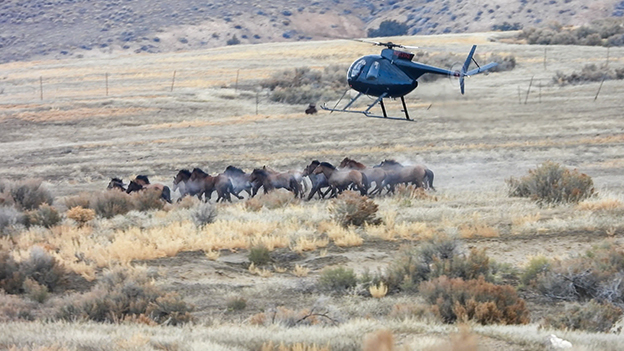
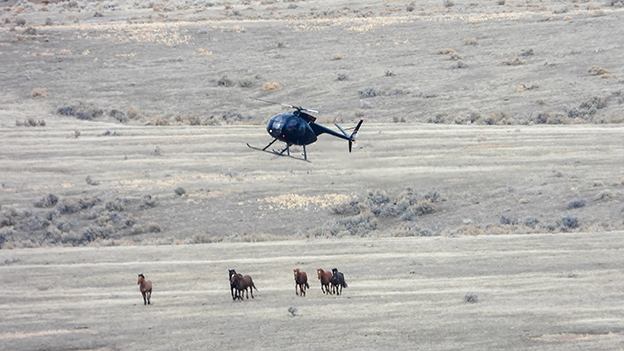
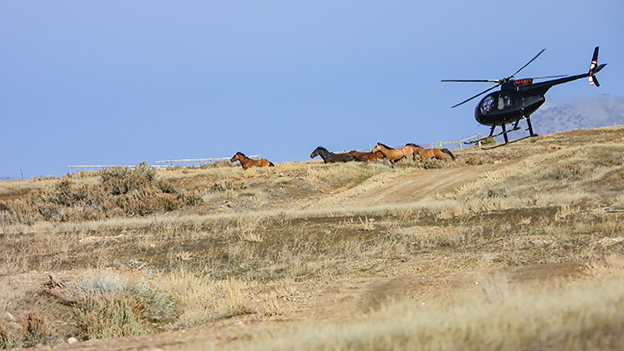
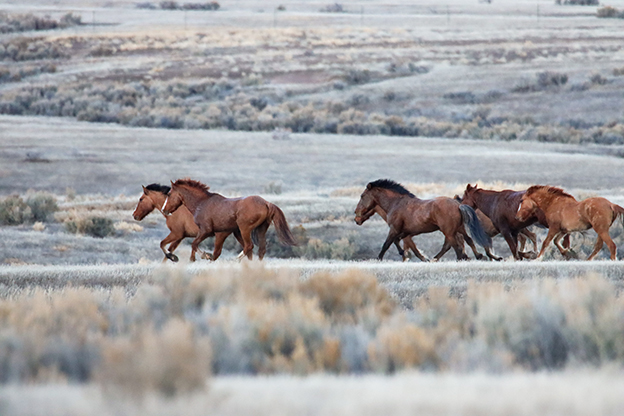
Images of different groups of horses targeted and trapped by helicopter today.
Nottakingmetoday0.mp4
Some, like this white one running the opposite direction of incoming horses, evaded the trap.
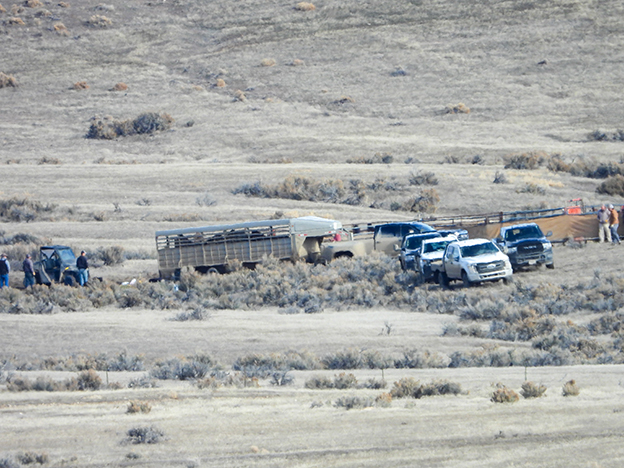
Muddy conditions caused some trucks to get stuck at the trap. At one point, horses sat for over an hour on a trailer.
Date: January 27, 2024
Location: ~14 miles south of Winnemucca, NV (same as the 25th and 26th)
Weather Conditions:
35°F–45°F
Mostly sunny
Summary:
Clean-up operations occurred today, where the day is short to capture missed horses before moving to another trap site. One group of ~19 horses was brought into the trap, after which operations ended. The horses at this trap site are being hauled directly to an Off-Range holding facility near Winnemucca, NV which is closed to the public.
Total Captured Today (from BLM reports):
~19 horses (BLM reports not yet updated)
Observations and Events:
- 6:45 AM: Met with BLM and caravanned to the same trap site as on the last two days
- Today is a cleanup day: A short day rounding up horses missed before moving to a new trap site
- They are rounding up on the Sanoma Herd Area
- 8:00 AM: Brought in a group of ~19 horses
- All horses captured at this trap site are being hauled directly to an Off-Range holding facility near Winnemucca, NV which is closed to the public
- 10:00 AM: Ended operations for the day
- Work began to move locations for tomorrow
- Tomorrow, operations will be based out of Battle Mountain
The large group of horses trapped today. This is the last day of operations at this trap site, and operations ended early to move trap locations.
Date: January 26, 2024
Location: ~14 miles south of Winnemucca, NV (same as the 25th)
Weather Conditions:
20-30 degrees
Summary:
The catch pen and trap appear to be too small for larger groups of horses (>20) and they appeared over capacity during a larger run. The highlight of today’s operations was a black stallion that repeatedly defied the helicopter. It is unclear whether the stallion and the horses with him were brought in during a later run, or if they still remain on the range. Conditions on the range were muddy, and the afternoon ended with sleet turning to snow. No injuries or deaths were observed or reported.
Total Captured Today (from BLM reports):
125 (49 stallions, 56 mares, and 20 foals)
Observations and Events:
6:45 AM: Met BLM at Grass Valley Community Center This is the second day at this trap site AWHC is the sole observer
9:00 AM: The first run came in, approximately 6 horses
9:20 AM: 5 horses that had separated from the previous, larger group were trapped
10:00 AM: Helicopter refueled
11:00 AM: A group of approximately 15 horses enters the trap
11:36 AM: A semi livestock truck going to holding passed by
1:00 PM: The pilot brings in approximately 20 horses The catch pen and the trap appear over capacity
1:42 PM:The pilot is seen bringing in a group of 5 horses from the mountains southeast of observation (see video)
o The horses appear tired to AWHC’s onsite observer
o They are herded to the based of the mountain
o The stallion repeatedly turns and runs towards the helicopter
o He runs back up the mountain several times, the rest of the horses with him following
o Mud flies from the horses’ feet as they run3:30 PM: The last group of the day is brought in By this time, it was raining sleet and beginning to snow
4:00 PM: Operations ended for the day
A black horse repeatedly runs towards the pressure of the helicopter, then turns up the mountainside. There are three horses with him, and they follow his movements. It is unknown whether or not the stallion and the other three horses were later brought into the trap with a larger group or remain on the range.
A few groups driven into the trap by helicopter during today’s operations.
Date: January 25, 2024
Location: ~14 miles south of Winnemucca, NV
Weather Conditions:
- 32°F–45°F
- Foggy and rainy in the morning
- Weather cleared in the afternoon
Summary:
Observation is ~1 mile away from the trap site. Cows were actively grazing in fields between observation and the trap site. The general area has a lot of wire fencing, often used to create boundaries for cattle in grazing allotments. Wire fencing is difficult for horses to see and is an entanglement risk. In the afternoon, several horses fall/appear to be entangled in something as they are being driven into the trap by helicopter.
Total Captured Today (from BLM reports):
68 (32 stallions, 29 mares, and 7 foals)
Observations and Events:
- 6:45 AM: Met BLM at the Grass Valley Community Center
- Caravanned ~14 miles to the new trap site
- The trap is ~1 mile away
o Wings are visible
o The alley to the trap is visible
o There is not a good view of the trap itself as it is shaded by terrain - Observation is along a semi-busy road, behind a fence
o Cattle are grazing on the other side of the fence - This trap area has a lot of fencing, which is expected to be related to grazing allotments
- 11:00 AM: ~12 horses are brought in
- 11:30 AM: Second run, 5 horses
- 1:18 PM: ~25 horses
- 1:25 PM: Livestock semis are parked up the road at the corner
o No livestock trailers have come down - 1:45 PM: Livestock trailers are loaded and headed towards semis to transfer
- 2:07 PM: Another run of ~7 horses
o At least 3 horses fell
o As they come back around, they appear to get entangled in something headed into the wings - 2:40 PM: 5 horses are captured
- 3:19 PM: Another ~8 horses are trapped
- Operations end for the day
Horses fall and appear to be briefly entangled while being navigated towards the trap.
The view of the trap from observation. Trap wings are on the left side of the image and the alleyway and trap itself are on the right side.
A closer view of the alleyway and trap. A truck and livestock trailer on the right side of the image are leaving the trap area, driving parallel to permanent fencing. Fencing, an entanglement hazard for horses, is common in this area.
There are a number of cattle grazing in this area.
Horses driven into the trap wings by helicopter. Cattle graze in the foreground. There is a significant amount of fencing in this area, which is suspected to be related to grazing allotments for cattle.
A group of 5 horses being brought into the trap.
Livestock semis parked and waiting for the transfer of horses from livestock trailers hauled by trucks.
Livestock semi headed to Off-Range corrals.
Date: January 24, 2024
Summary:
There were no operations today due to rain. The trap will be moved back to the Winnemucca side and there will be a new trap site tomorrow. Below are some photos from operations thusfar in the East Pershing Complex FY 2024 roundup.
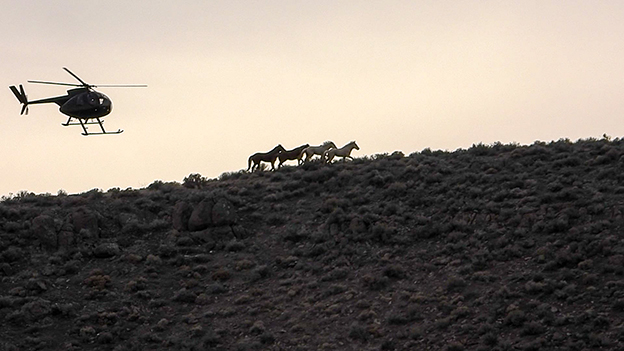
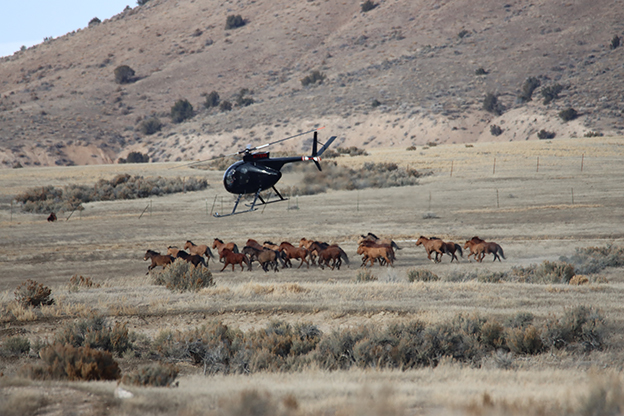
Helicopters are used to invoke enough fear in horses to get them to run. The pilot changes their position to drive the moving horses in the direction of the trap. Many HMAs have fencing between wild horses and where traps are constructed, increasing the danger for horses of entanglement and injury or death. Under CAWP, the BLM Contracting Officer’s Representative or Project Inspector must determine the appropriate width of the fencing to allow safe passage and if actions need to be taken to increase visibility.
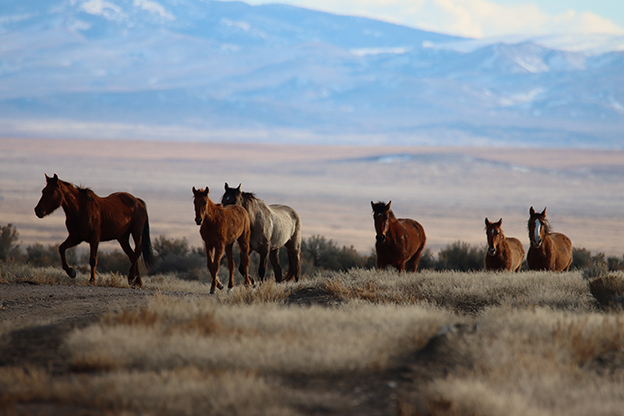
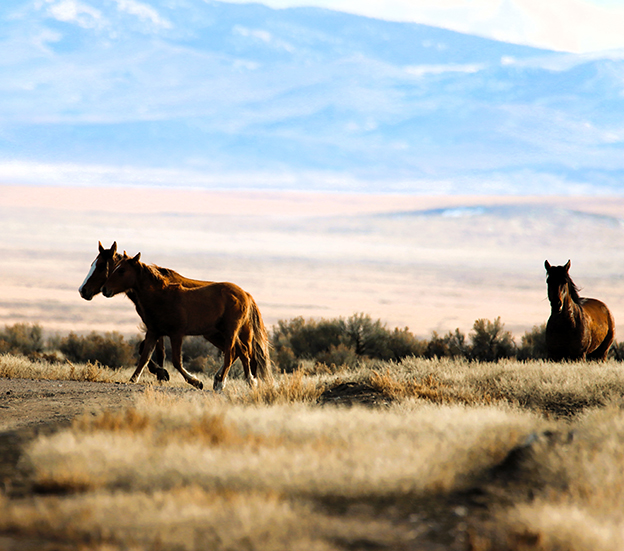
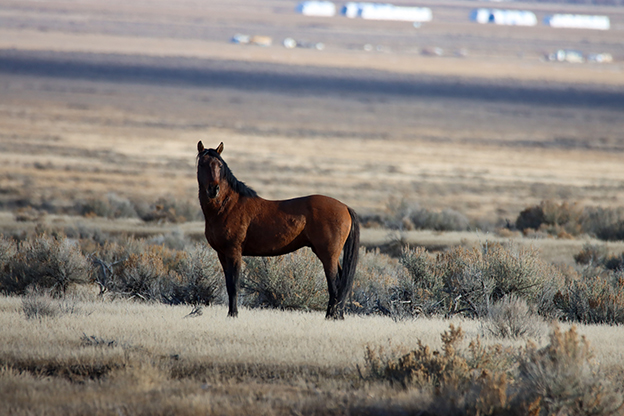
A band of horses that was gathered on the 21st. The main group is composed of mares and foals. Bringing up the rear is the band stallion, who turned to look at AWHC’s onsite observer as the group went by and towards the trap.
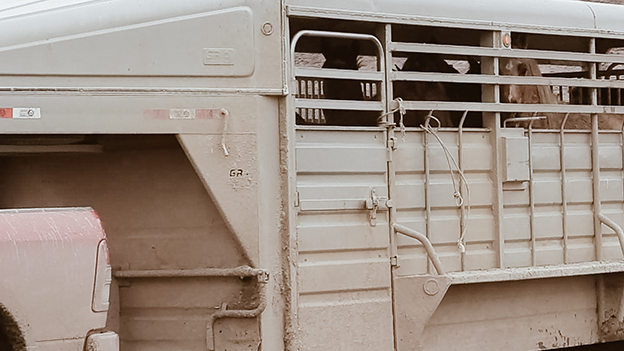
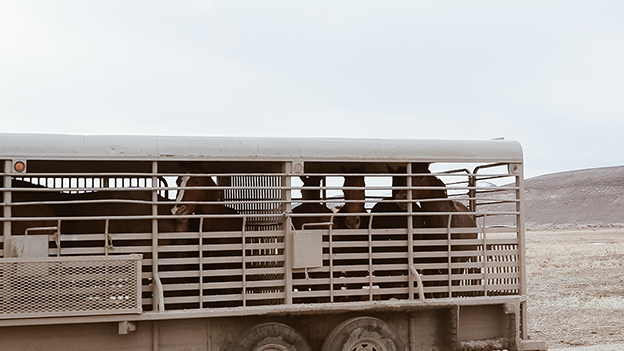
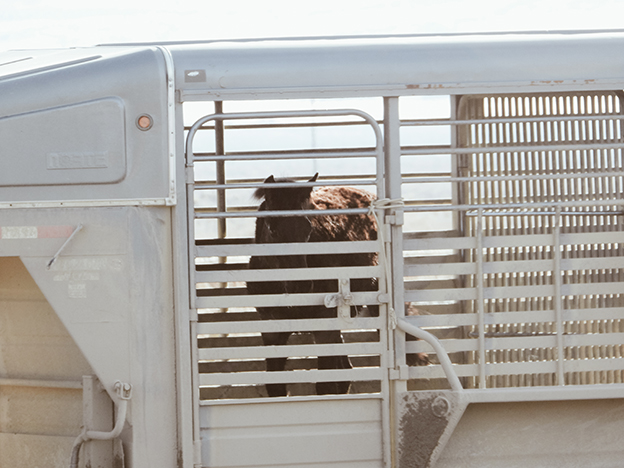
Horses are transported on livestock trailers and separated out by age (foals and adults) and sex (mares or stallions). The young horse in the last image is one that was roped in order to be captured.
Date: January 23, 2024
Summary:
There were no operations today due to wet conditions. BLM reports indicate horses were shipped to Off-Range corrals.
Date: January 22, 2024
Location: ~61 miles driving distance South of Battle Mountain (same as the 21st)
Weather Conditions:
- 36°F–44°F
- Rain all day
Summary:
AWHC was the only observer onsite today. Operations continued at the same trap as the 21st. The trap appears well constructed with sufficient space for horses and a good loading location. One downside is that horses must be navigated through a gap in a fence to reach the trap, but so far, no horses have made contact with the fencing. There were 6 runs over the course of today’s operations with no incidents observed by AWHC or reported by the BLM. With rain all day, mud continues to be a hazard.
Total Captured Today (from BLM reports):
78 (37 stallions, 27 mares, and 14 foals)
Observations and Events:
- 6:30 AM: Met at BLM office in Battle Mountain
- The trap is in the same arrangement as the day previous
- No horses have been tangled in jute fabric or collided with any capture pen panels
- Unlike previous traps from the same contractor, this trap has sufficient space for incoming horses and appears constructed well
- The trailer area appears well situated for convenient loading
- One hazard is nearby fencing, which the pilot must navigate horses through
o So far, no horses have made contact with the fencing - The pilot is permitted a perimeter of ~7 miles to work within
- Horses appeared to come into the trap relatively easily, despite wet terrain from rain
- Deep, thick mud is a concern
o Horses have to work harder to pull their feet free, increasing risk of injury to limbs
o The inside of livestock trucks are slick and muddy - There were 6 runs today in total with no incidents
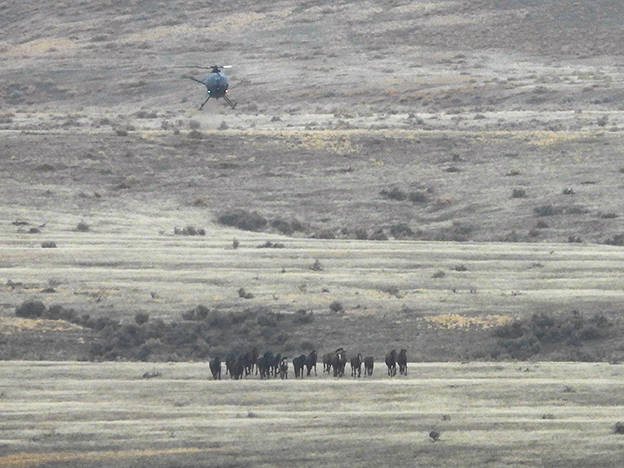
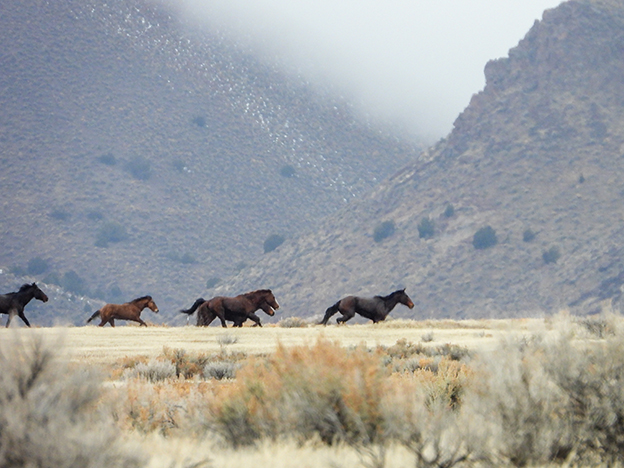
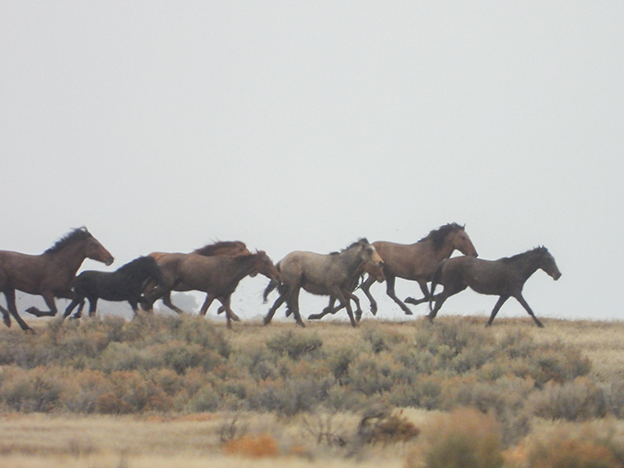
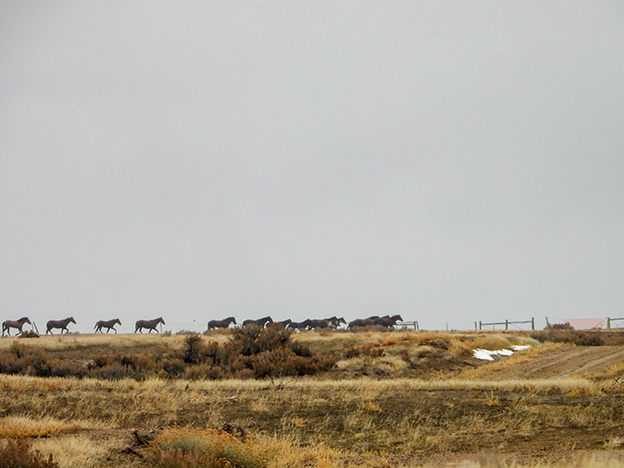
fencing.mp4
The helicopter pilot must navigate horses through a gap in fencing in order to reach the trap. Operations today went smoothly, with no horses making contact with the fence.
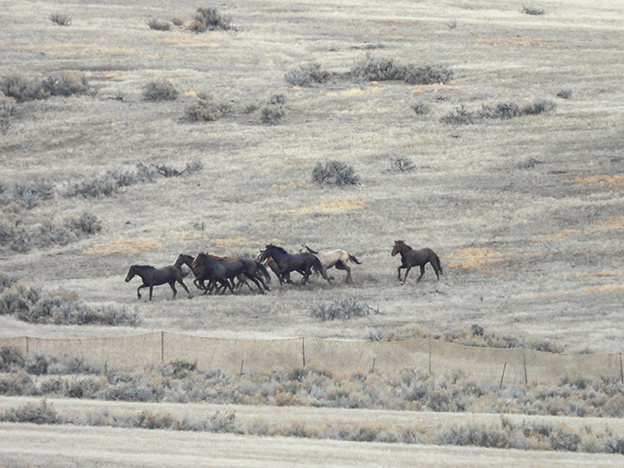
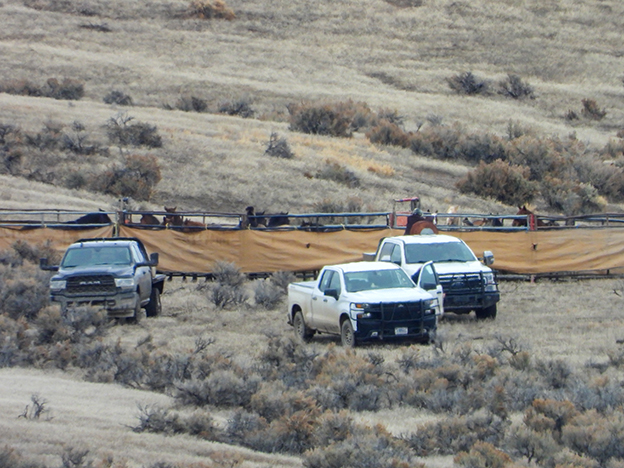
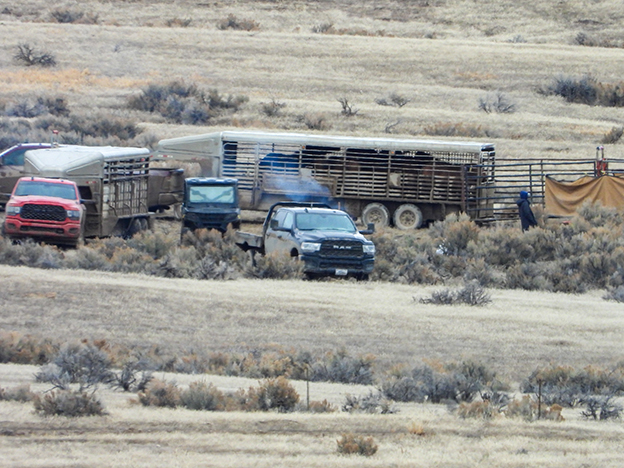
Date: January 21, 2024
Location: ~61 miles driving distance South of Battle Mountain
Weather Conditions:
- 20°F–40°F
- Sunny in the morning
- Overcast
Summary:
Observation was only ½ mile from the trap today, offering some of the clearest views of the trap and horses so far this roundup. The trap appears to be setup to CAWP standards. The biggest area of concern is thawing roads, creating muddy conditions that may be difficult for livestock trucks transporting horses to temporary holding. Runs went smoothly in the morning, with 3 runs coming in without issues. In the afternoon, one horse is roped and falls, but does not appear to have injuries. No injuries or deaths were seen or reported today.
Total Captured Today:
100 (35 stallions, 49 mares, 16 foals)
Observations and Events:
- 6:30 AM: Met at the BLM office in Battle Mountain
- Caravanned for 61 miles to observation
- AWHC is the only observer on site today
- Observation is ~1/2 mile from the trap
- Contractor vehicles look to be in working order
- The trap appears set up in accordance with necessary catch pen space requirements
- Trap wings seem to have ample length and opening width, so horses can enter without distractions
- Thawing roads are extremely muddy and raises concerns about difficult conditions for livestock trucks transporting horses to temporary holding
- 9:15 AM: The first group of horses is successfully brought in
- 9:30 AM: A second group enters the trap
- 10:00 AM: A third run, also with horses entering the trap without issues
- 10:30 AM: The pilot left to refuel
- 11:20 AM: A group of 4 horses, with 1 horse splitting from the group
o 2 wranglers roped the yearling
o During the roping process, the horse fell to the ground twice but no injuries were seen
o The yearling was walked back to the trap by the 2 wranglers - 12:15 PM: A group of 3 horses (roan, pinto, and bay colt) enter the trap
- 3:00 PM: Two large groups are brought in
- End of operations
- BLM reports the average Henneke body scores of horses brought in today is 3.
A group of 12 horses driven into the trap. Video shows the helicopter navigating horses towards the trap up to the horses entering the trap.
A large group of wild horses running from the helicopter.
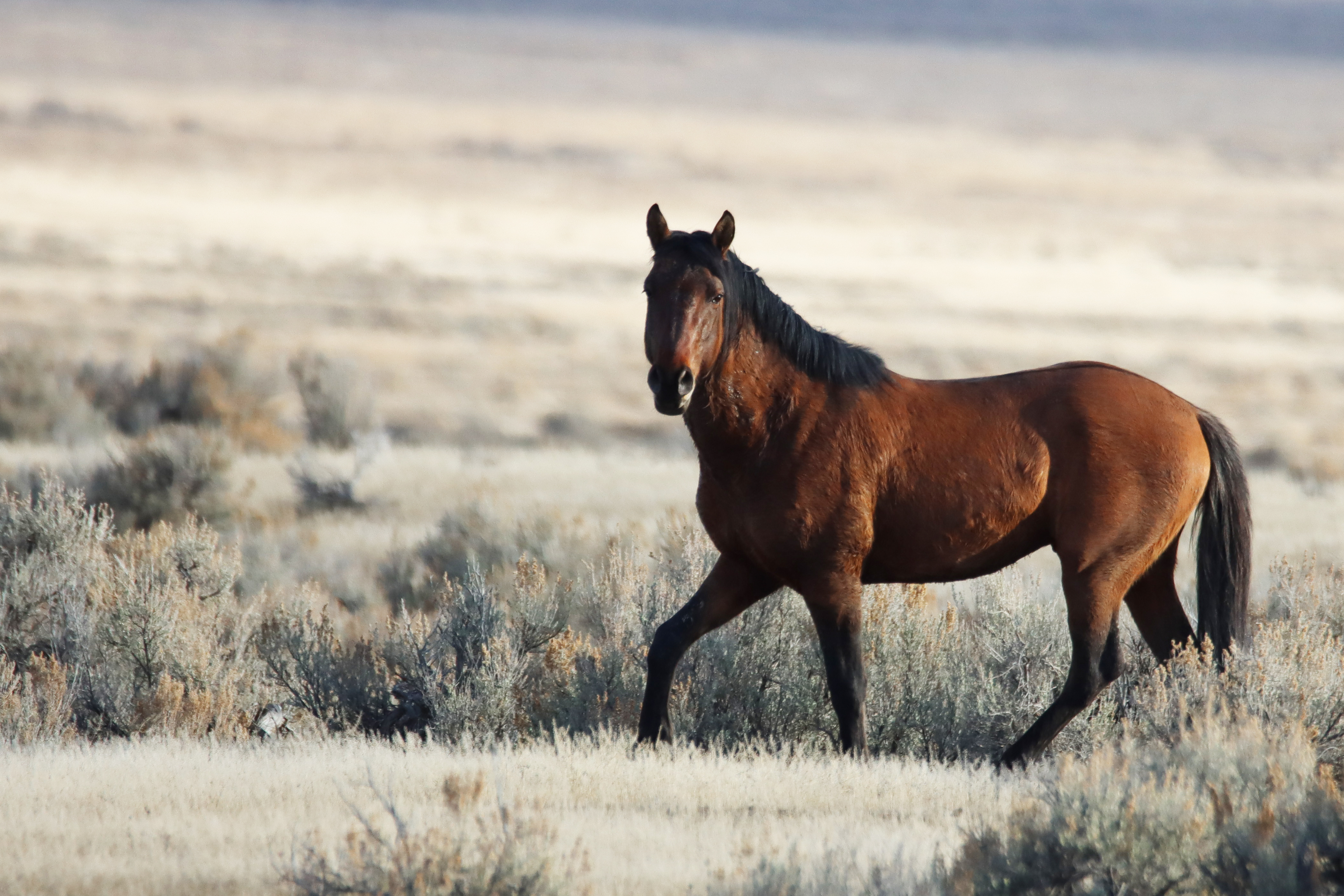
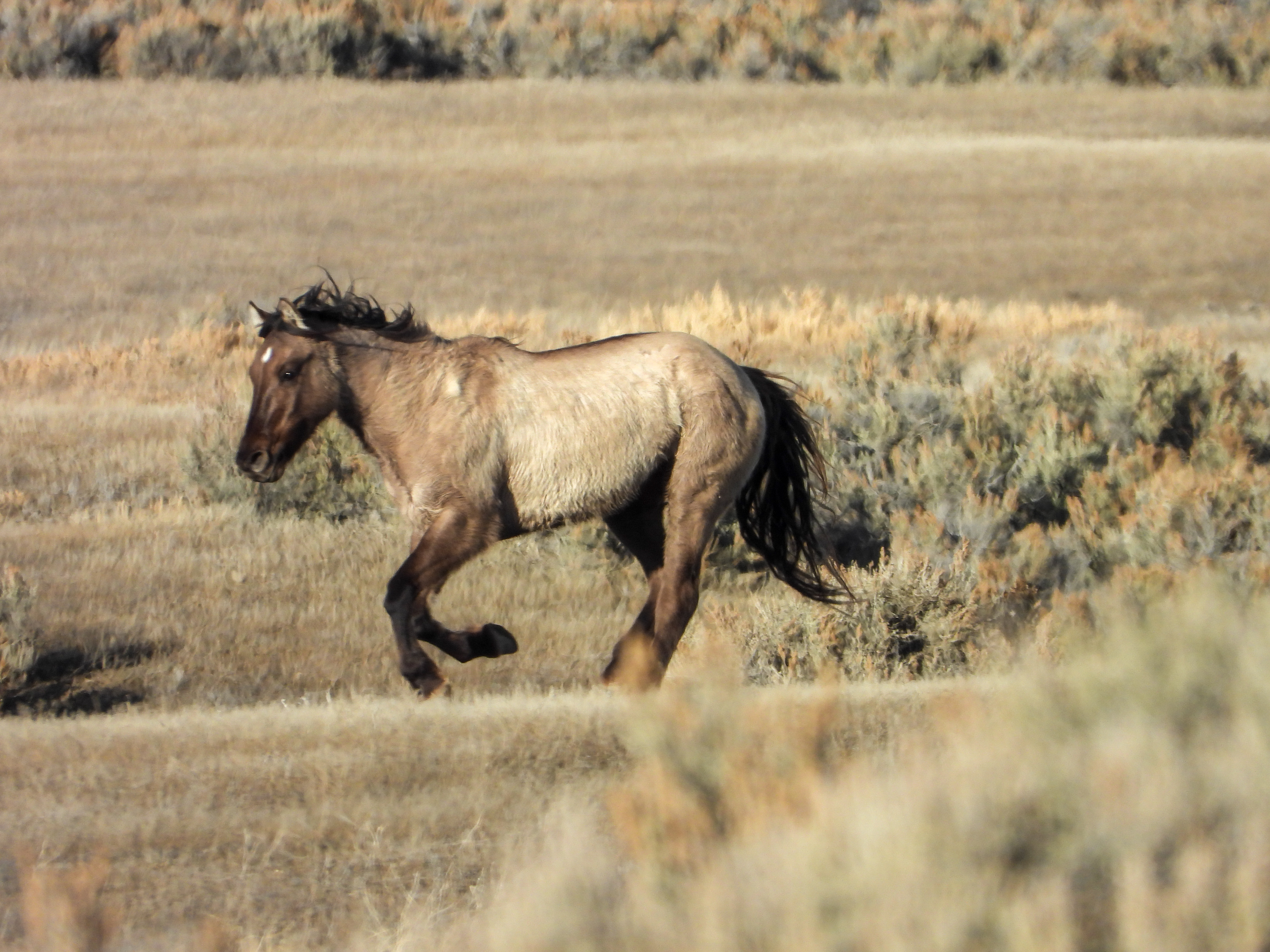
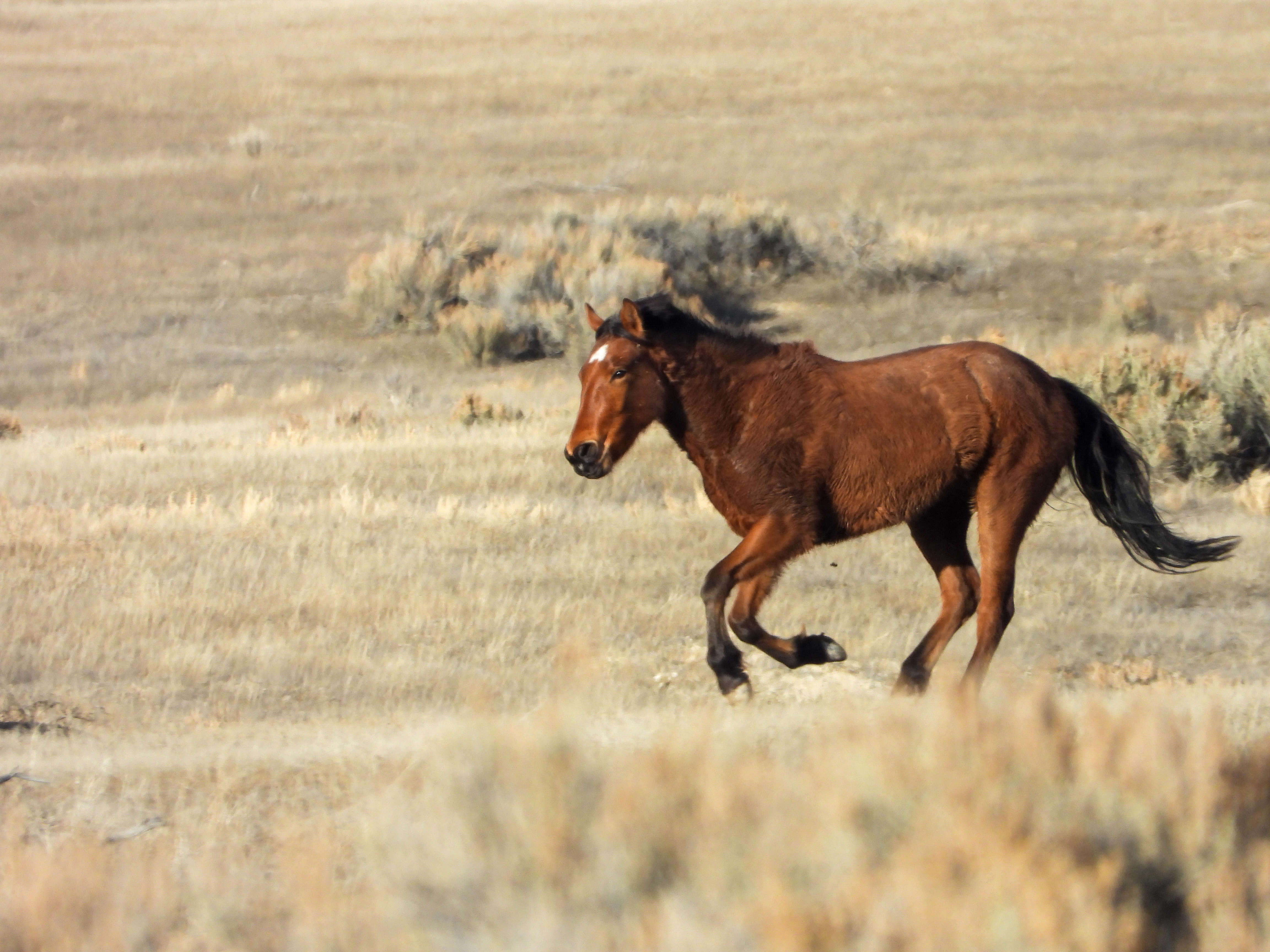
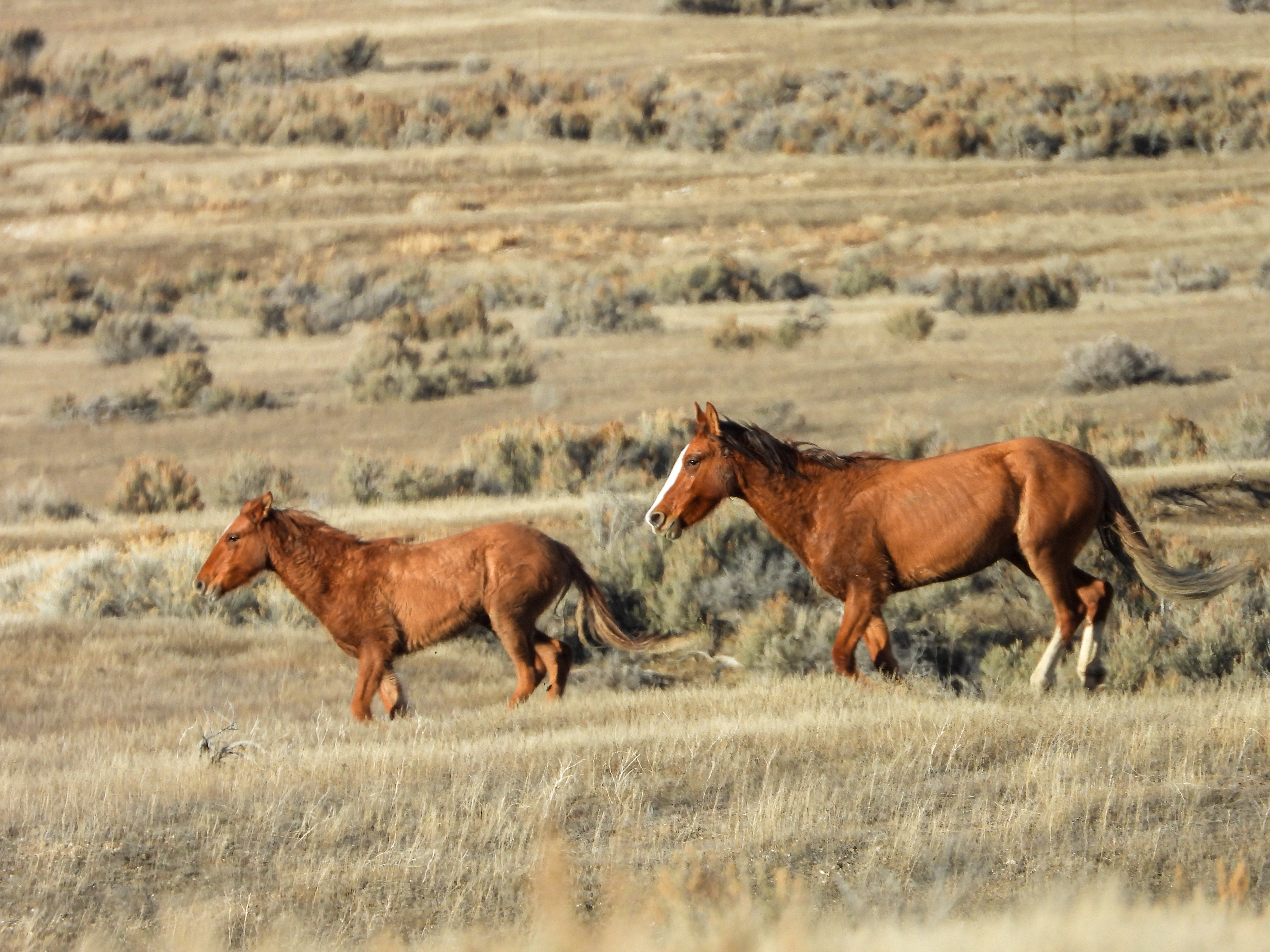
The trap was ~1/2 miles from observation today, allowing for good views of individual horses being driven into the trap and independent assessments of injuries and body condition. This group was headed by a bay stallion (first picture), who turned to look at AWHC's observer as they passed.
A yearling colt which separated from a group of 4 is roped by two wranglers. He falls twice during roping.
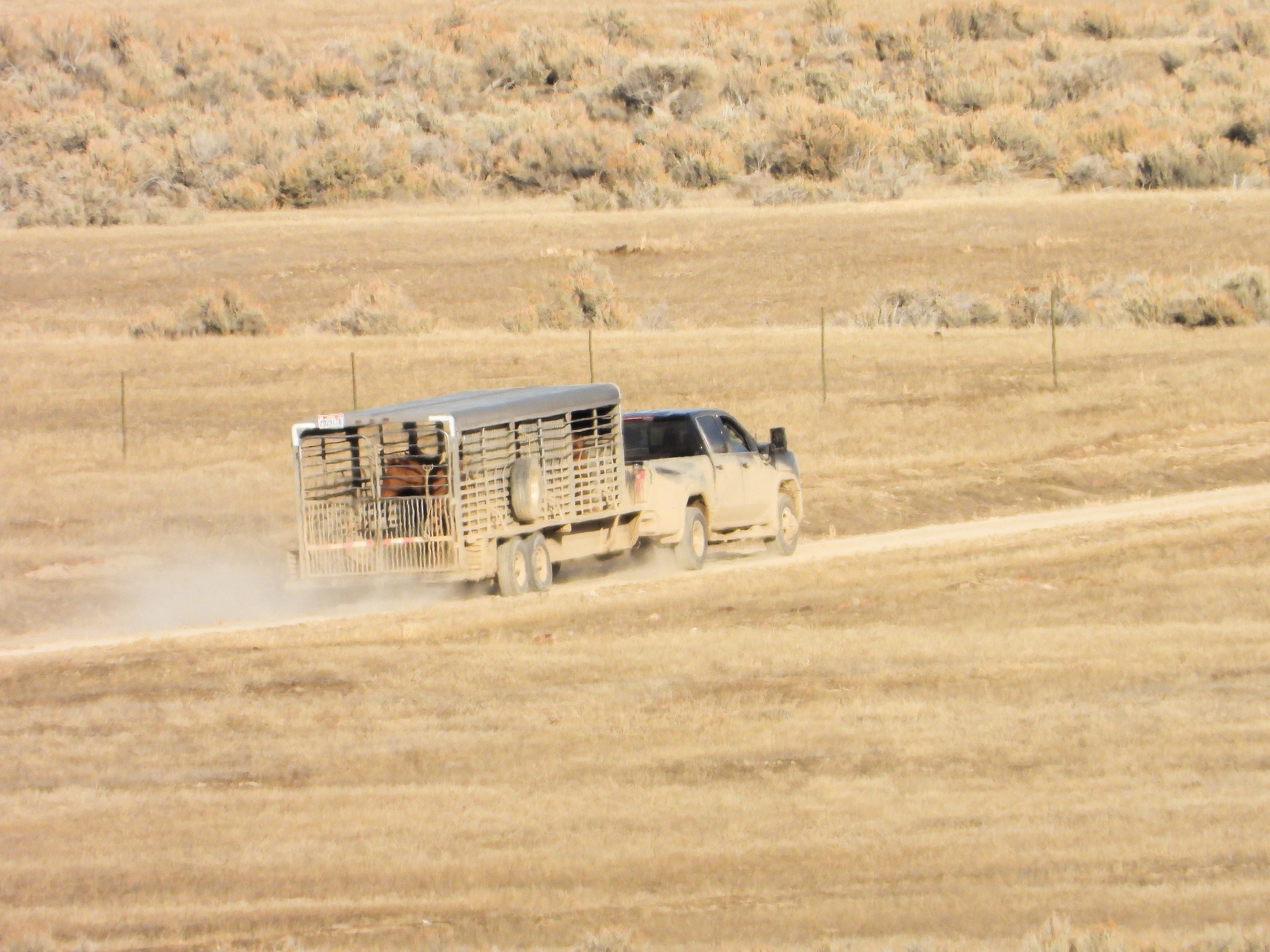
A loaded livestock trailer, drying mud on the sides, heads to temporary holding.
Date: January 20, 2024
Location: ~50 miles South of Battle Mountain, NV off of HWY 104 (same as the 19th)
Weather Conditions:
- 39°F–52°F
- Sunny in the morning
- Cloudy in the afternoon
Summary:
The pilot brought horses in sporadically throughout the day. The largest group was brought in at the end of the day. The trap site will move tomorrow.
Total Captured Today (from BLM reports):
42 (20 stallions, 19 mares, and 3 foals)
The BLM euthanized 3 horses with pre-existing conditions:
- 18-year-old bay stallion: a shattered nose sustained prior to gather was healing poorly which caused the horse respiratory issues
- 12-year-old dun stallion: blind
- 1-year-old bay filly: blind
Assorted photos taken today. Broken camera equipment prevented more thorough recordation.
Date: January 19, 2024
Location: ~50 miles South of Battle Mountain, NV off of HWY 104
Weather Conditions:
- 28°F–45°F
- Mostly Sunny
Summary:
Observation was much closer at the new trap site today, located ~1/4 mile from the trap. The wings and horses coming into the wings are visible, however the main part of the trap was obscured by topography and sagebrush. As was also the case yesterday, BLM’s CAWP (Comprehensive Animal Welfare Program) team was onsite. Operations were active, bringing in multiple runs of horses. Several horses separated from larger groups, including 1 colt, who was roped, and 3 horses that ran through the jute fabric of the trap wings.
Total Captured Today:
110 (32 stallions, 54 mares, 24 foals)
BLM euthanized 1 horse for a pre-existing condition:
- 17-year old roan stallion – broken left, front knee
Observations and Events:
- 6:30 AM: Met BLM personnel at the Battle Mountain office and caravanned approximately 45 miles South of Battle Mountain
- The alley of the trap in in clear view, but the trap itself is in a culvert and obscured by sagebrush
- 8:00 AM: The first run, of approximately 15 horses
o 3 horses run through the trap jutes (see video)
o After trapping the other horses, the pilot successfully navigates the remaining 3 into the trap - 8:30 AM: Run 2 of approximately 7 horses
- 9:30 AM: Run 3 with approximately 17 horses
o A colt gets separated from the group as they head towards the trap (see video)
o The pilot goes back for the colt after the other horses are successfully captured
o The colt’s breath is visible in the cold air
o The helicopter flies above the colt, but the colt does not move
o A wrangler on foot runs out to the colt and waves their hands to attempt to get the colt to move
o Two additional wranglers on horseback arrive and rope the colt
o The colt bucks and tries to escape
o During the roping of the colt, the Judas horse (a domestic horse let loose in front of wild horses to lead them into the trap) gets loose (see photo) - The pilot brings in a few more horses along with 2 that had broken off from the group of trapped horses
- 11:00 AM: Helicopter refuels
- 12:40 AM: Pilot brought in another group of ~12 horses
o 5 horses split from this group, and the pilot went back to push them into the trap as well - 12:53 PM: Another group of around 8 horses are brought in
- 1:40 PM: A large group is brought into the trap
- The helicopter refuels again
- 2:30 PM: The last 4 horses of the day are brought in
- 3:30 PM: Operations end for the day
- BLM reports indicate body scores ranged from 3 to 5
Three horses from Run 1 escape through the jute fabric of the trap wings. The helicopter pursues them and successfully pushes them back into the trap.
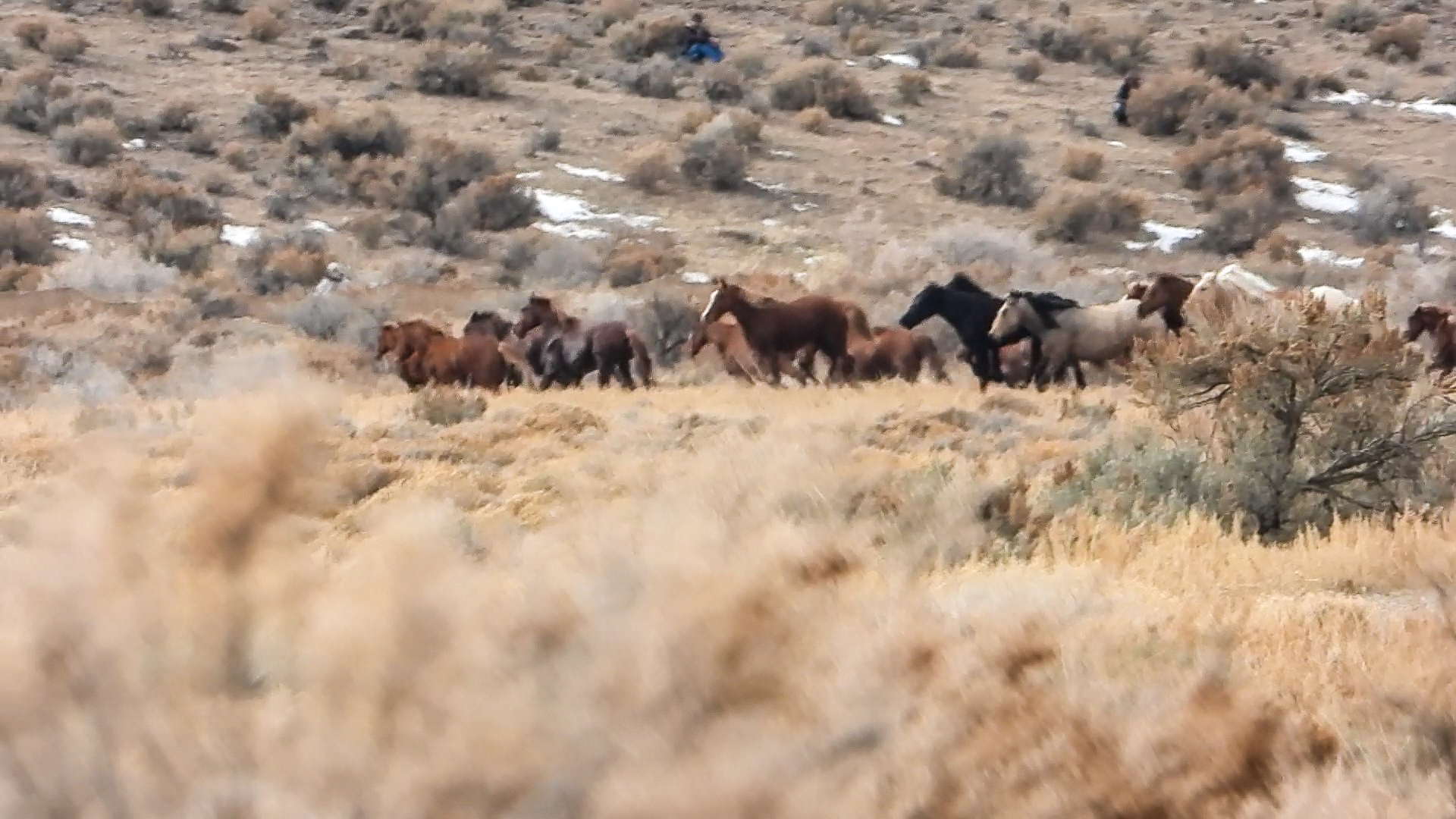
Horses in the wings of the trap. Trap wings are visible on the middle, left side of the image.
A helicopter, 1 wrangler on the ground, and 2 wranglers on horseback are needed to bring in a colt that is separated from a group of horses driven into the trap
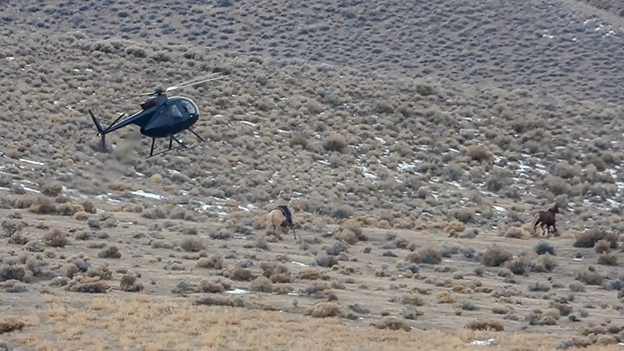
A wrangler and helicopter pursue a horse in order to rope it.
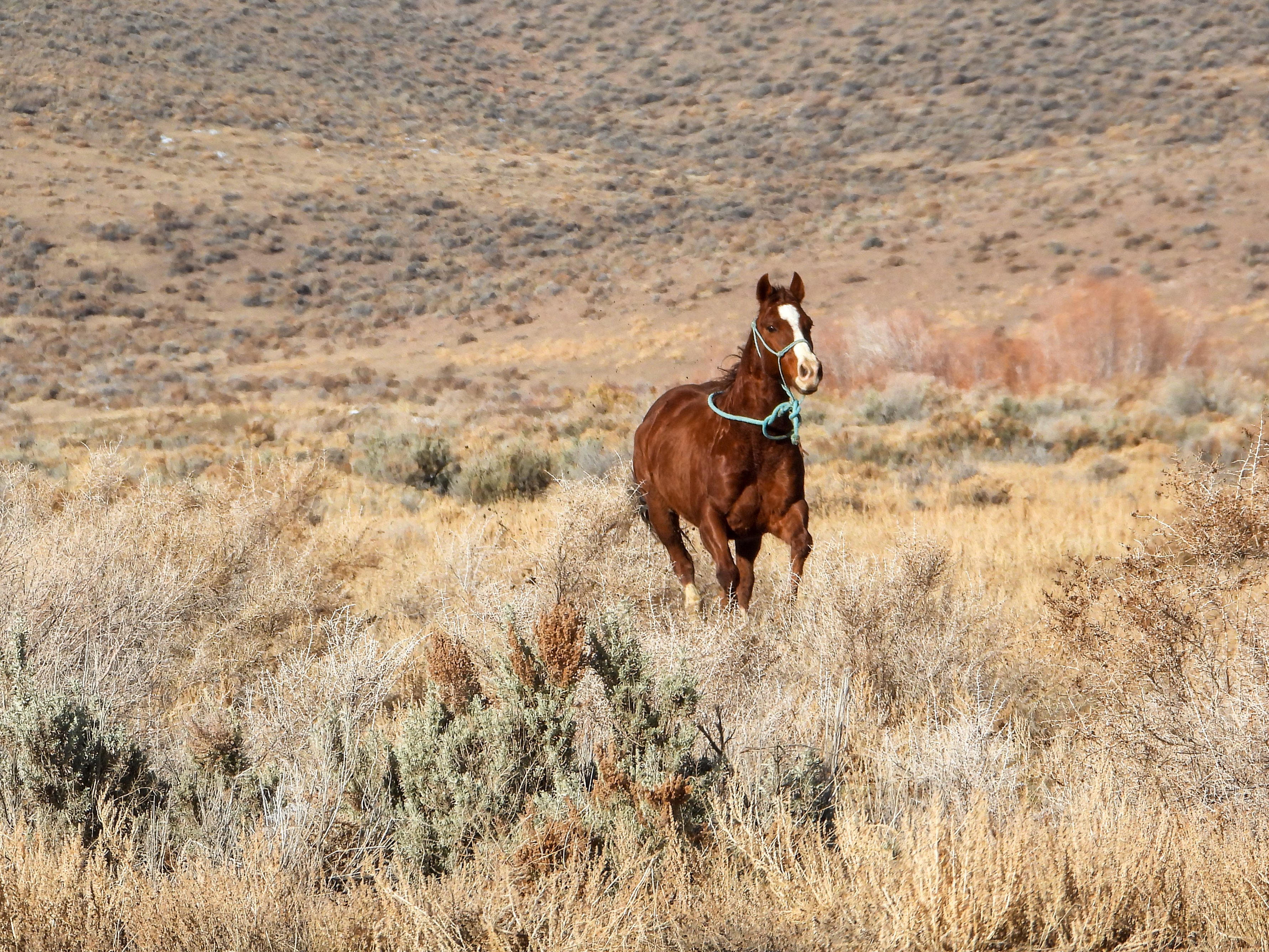
Escaped Judas horse from Run 3
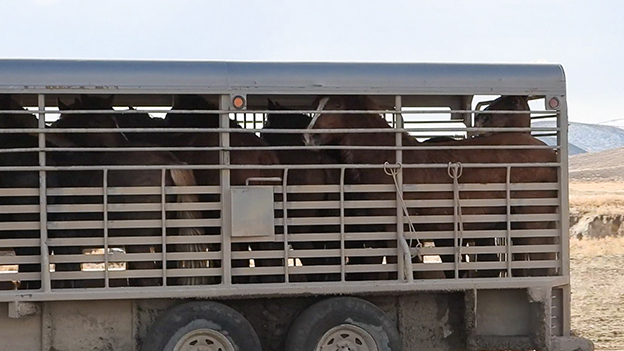
Horses on a livestock trailer headed to temporary holding.
Date: January 18, 2024
Location: ~15 miles south of Battle Mountain (same location as the 17th)
Weather Conditions:
- 28° F – 45° F
- Sunny
Summary:
Horses were not visible until they entered the trap as they were being brought in from close to and behind the trap site. The trap is the same location as the 17th, and ~2 miles away from observation. Operations were short today as the trap will be moved tomorrow. Observers were allowed a tour of the trap in the afternoon.
Total Captured Today (according to BLM Reports):
37 (11 stallions, 22 mares, and 4 foals)
The BLM euthanized 2 horses for pre-existing conditions:
- 8 year old bay mare – equine lordosis (swayback)
- 15 year old sorrel stallion – soft tissue injury to right, rear fetlock (this injury was visible to AWHC’s onsite observer)
Observations and Events:
- 6:30 AM: Met with BLM personnel and caravanned to observation spot as on previous days
- Horses were brought in from near and behind the trap; they were not visible until they were at the trap
- Observers were given a tour of the trap
- The roads heading to the trap were churned up and muddy
A view of the trap. Observers were given a tour of the trap site after observations had ended for the day.
Date: January 17, 2024
Location: ~15 miles south of Battle Mountain
Weather Conditions:
- 30° F – 41° F
- Cloudy
- Windy
Summary:
Operations were at a new trap site today. Rain and snow created poor visibility conditions that grounded the helicopter for part of the day. At a distance of ~2 miles, the trap and wings cannot be seen clearly. A small group was rounded up in the morning, including the horse that fell on the 16th, and a large group of ~40+ horses was captured in the afternoon. Observers were not permitted to visit temporary holding which is located on private land.
Total Captured Today (according to BLM Reports):
44 (23 stallions, 16 mares, and 5 foals)
The BLM euthanized 1 horse:
- 8-year old bay stallion, club-footed in both rear feet
Observations and Events:
- 6:30 AM: Met with BLM personnel and caravanned to observation spot
- 3 horses were near observation (including the horse that fell the day before) and were captured first
- Rain and snow created poor visibility, grounding the helicopter for a few hours
- Mid-afternoon, the pilot is able to fly again
- After being out of site for over an hour, the pilot returns with a large group of approximately 40+ horses
- Three horses fell behind and they were not driven into the trap
- Operations ended for the day
Temporary Holding
Observation at temporary holding continues to be denied. It is located on private land and cannot be seen from a public road.
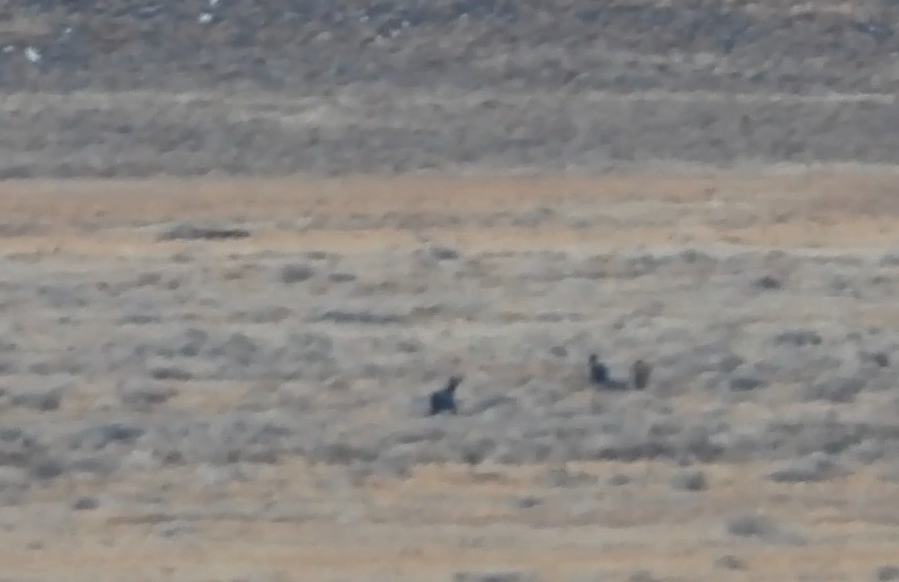
Three horses gathered in the morning
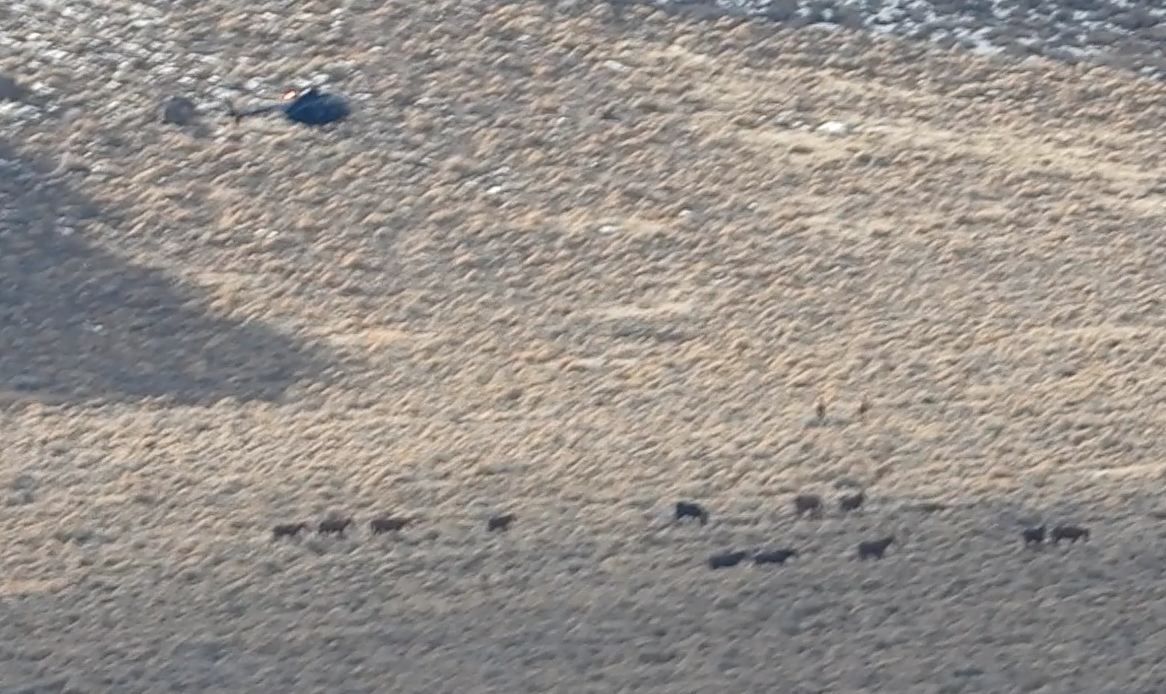
The helicopter and part of the large group that was brought in the afternoon. More horses are outside of the image to the left and the right. This image is an example of difficult viewing conditions at the observation point.
Date: January 16, 2024
Location: ~20 miles South of Battle Mountain
Weather Conditions:
- 20° F – 39° F
- Overcast
Summary:
There were two members of the public onsite today, including AWHC. Trap operations were difficult to see as the trap was over 2 miles away. The pilot targeted horses in the mountains in the early part of the day, and then concentrated on horses closer to the observation point. Two horses were roped.
Total Captured Today (according to BLM Reports):
99 (47 stallions, 36 mares, and 16 foals)
Observations and Events:
- 6:45 AM: Met with the BLM at Battle Mountain BLM office
- Caravanned 40 miles to the trap site
- Observation of the trap was obscured and ~2 miles away
- In the early part of the day, the pilot captured horses near the bottom of the mountains
- A foal was seen falling behind in one of the runs
- Later in the day, the pilot targeted horses closer to observation
- The groups scattered in different directions
- A few horses were roped near the trap:
o A limping horse
o A smaller horse - One horse separated from its band, falling after the helicopter pursued it
o He appeared to have issues with his back end
o He eventually walks off alone, favoring his hind end - Trailer loading and loaded trailers leaving the trap site were not visible from the observation location
- BLM reports list average Henneke body scores of between 3 and 5
Temporary Holding:
Temporary holding is on private land. It is constructed behind hay stacks and is not visible from the public road.

Observation is ~2 miles from the trap site, and images and video are distorted by heat waves.
A video with two parts showing 1) An example of a run with horses being successfully driven into the trap and 2) a horse that split from a group and fell
Date: January 14, 2024
Location: ~30 miles east of Lovelock, NV (same as the 13th)
Summary:
No roundup operations today. Communication the last two days has been poor and changes have occurred at the last minute. As on the 13th, observers met with BLM personnel at Grass Valley Rd. After arriving at the observation point and setting up, observers were told that the trap site would be moved due to the location of the horses. Tomorrow’s trap site is expected to be near Battle Mountain.
View of the trap site from observation. No operations occurred today, and the trap site will be dismantled and moved due to the location of the horses.
Date: January 13, 2024
Location: ~30 miles east of Lovelock, NV
Summary:
No roundup operations today. We met with the BLM at 6:30 AM at Grass Valley Rd. and traveled 90 miles to the trap site. After arriving at the trap site at 8:00 AM, observers were told the helicopter would not be flying today.
Snowy conditions at the observation site.
Date: January 12, 2024
Summary:
BLM daily reports state that no gather or shipping operations occurred. It also notes that temporary holding was dismantled and moved to a new location. The new location is not known at this time.
Date: January 11, 2024
Summary:
No roundup operations. The BLM euthanized 2 horses with pre-existing conditions. See BLM Daily Report.
Date: January 10, 2024
Summary:
No roundup operations occurred today.
Date: January 09, 2024
Summary:
The trap site moved back to the North Stillwater HMA. Due to snow and hazardous driving conditions, AWHC did not attend roundup operations on this day. BLM reports indicate that a total of 145 horses were captured (44 Stallions, 69 Mares, and 32 Foals). No deaths or injuries were reported.
Date: January 08, 2024
Location: Humboldt Herd Area
Weather Conditions:
- 17° F – 32° F
- Partly cloudy in the afternoon
Summary:
BLM’s Comprehensive Animal Welfare Program Team was onsite today. While still in the Humboldt Herd Area, today was a new trap site. The observation position was close, offering good views of the trap located on the hill. Mostly small groups of horses (<10) were brought in today, with a few runs of only single horses. Several horses, from different runs, collide with the trap panels, but there are no reports of injuries and no deaths. The trap will move to the North side of the complex tomorrow.
Total Captured Today (according to BLM Reports):
54 (28 stallions, 22 mares, 4 foals)
Observations and Events:
- 7:30 AM: Met with the BLM
- Caravanned to the new trap site, pausing for the CAWP team to pass
- Observers are positioned an estimated 0.2 miles from the trap
- Views of horses in the trap are good, but the trap’s position on top of a hill makes it difficult to see the trap wings
- The helicopter was already in the air on arrival, though the trap had not been fully set up
- The first run of horses was brought in without issue
- During loading, a tarp was used to pressure horses onto the trailer
o The BLM has confirmed cattle prods have been used during the course of this roundup, though it is not known to observers when and under what conditions - Dense fog grounded the helicopter temporarily
- ~11:00 AM: The helicopter resumes flight
- After a bigger run (~12 horses) enters the trap, a horse panics while being pressured further into the trap and tries to jump panels several times, falling in the process
- A few runs are brought in of single horses
o One of these horses runs into a panel and falls over - The next run, a larger group, is pushed towards the trap but does not follow the Judas horse into the trap. Instead, they head over top of the hill.
- After about 10 minutes, they were navigated back towards the trap and successfully entered
- The last run consisted of ~3 horses
- The trap will move to the north side of the complex tomorrow, near Winnemucca
- As on previous days in the Humboldt Herd Area, BLM reports average body condition scores of 2.5 to 3.5
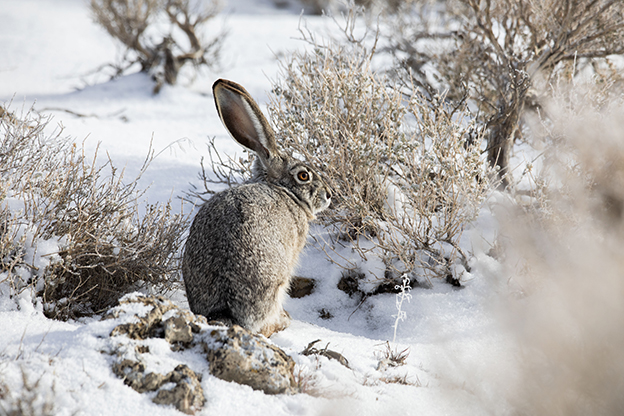
A jack rabbit near observation.
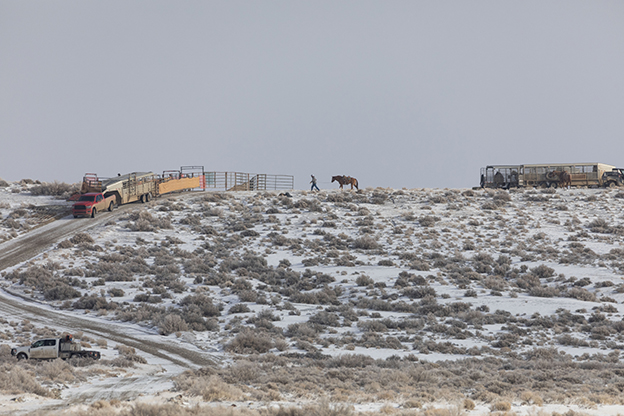
Today’s observation point provides a good view of the trap, which is located atop a hill.
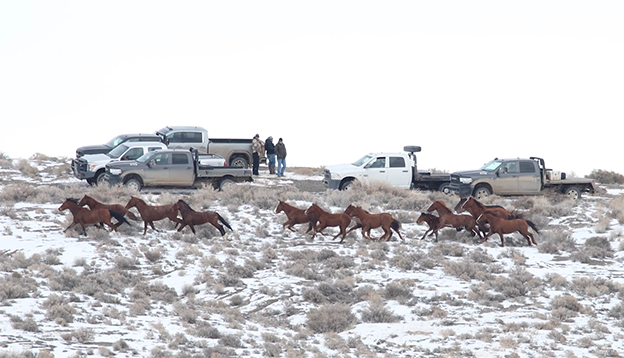
A larger group from today’s runs avoids the trap wings and come over the hill, passing by parked trucks being used in roundup operations. The group is brought into the trap after ~10 minutes.
A compilation of multiple runs of horses crashing into panels at the current trap site.
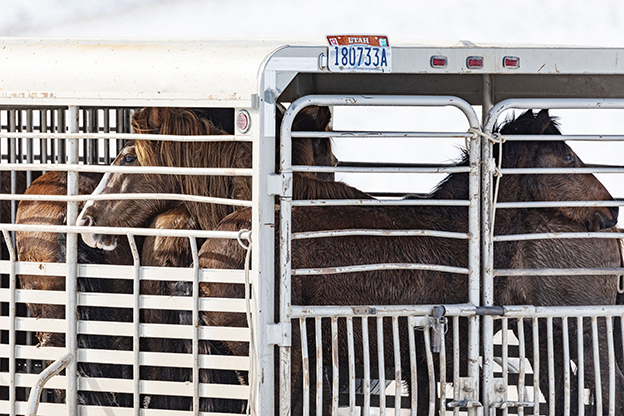
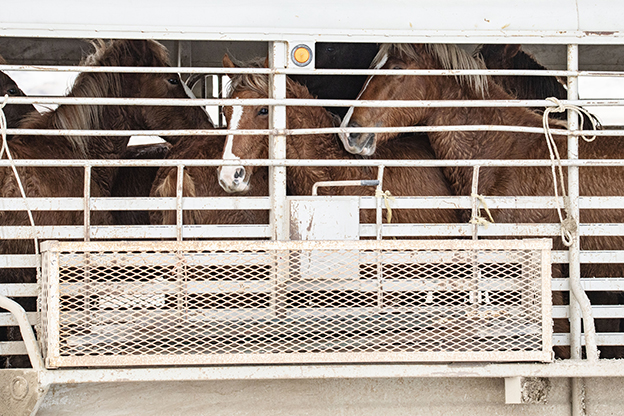
Horses on trailers to temporary holding. They appear sweaty.
Date: January 07, 2024
Location: Off Coal Canyon Rd, NV (in Humboldt Herd Area)
Weather Conditions:
- High of 34° F
Summary:
The new trap site is located within the Humboldt Herd Area. While the observation site is closer, trailers and equipment block the view of the trap. The wings are not visible. Operations today went about more slowly and there were no problems to report. The trap site was close to temporary holding and there were no injuries or deaths.
Total Captured Today (according to BLM Reports):
68 (31 stallions, 27 mares, 10 foals)
Observations and Events:
- 9:14 AM: ~12 horses are brought into the trap with no reported issues
- 10:05 AM: The pilot brought ~14 horses from the mountains, through steep terrain that looked potentially dangerous
- 10:36 AM: A group of ~7 and 3 horses are brought in to the trap
- 11:10 AM: The pilot drove ~10 horses into the trap and then refueled
- 1:15 PM: A group of ~6 horses enter the trap
- The trap site is expected to move for tomorrow’s operations
- BLM reports list Henneke body condition scores of 2.5 to 3.5
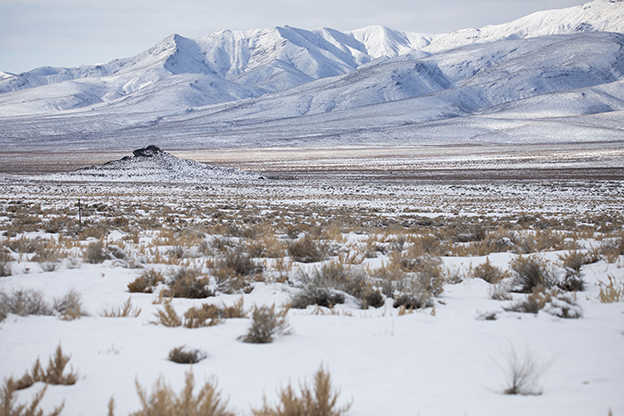
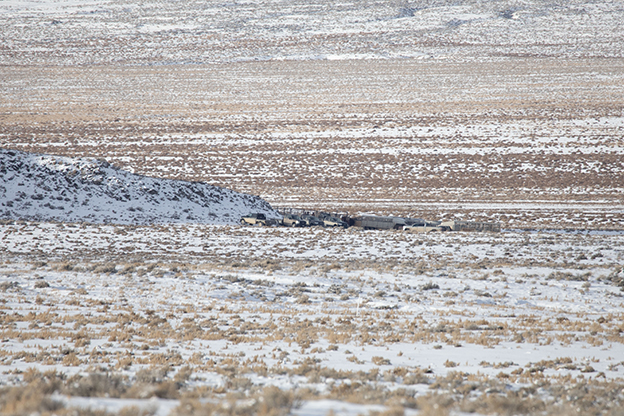
A view of the trap from the observation point, and an image taken with a zoom lens showing the vehicles and trailers between the observation point and the trap
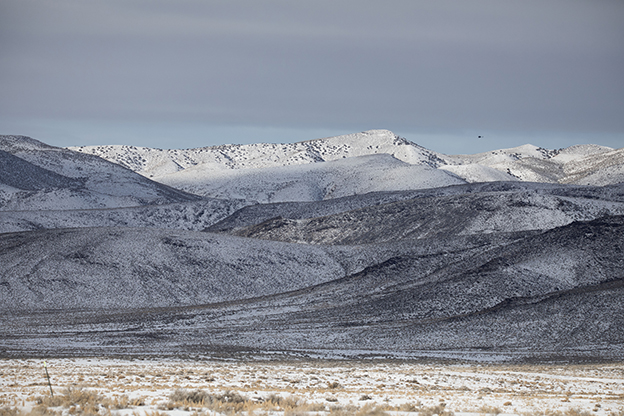
A view of the helicopter over snowy hills and mountains
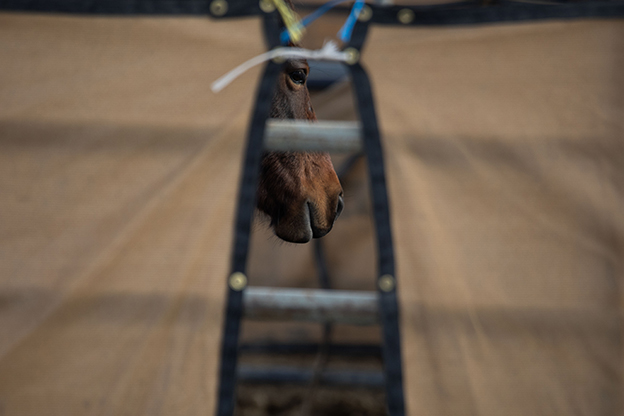
One of the horses currently at temporary holding, visible through a small gap between tarps.
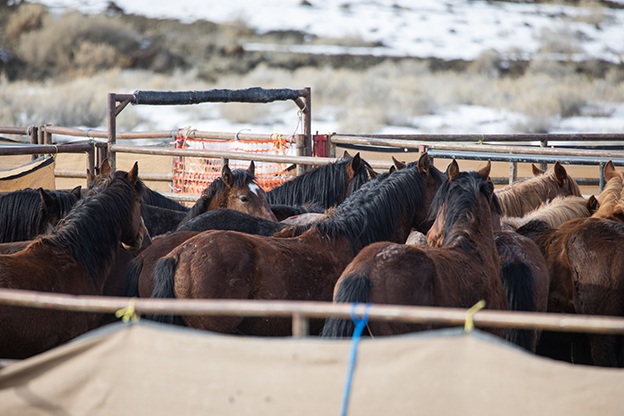
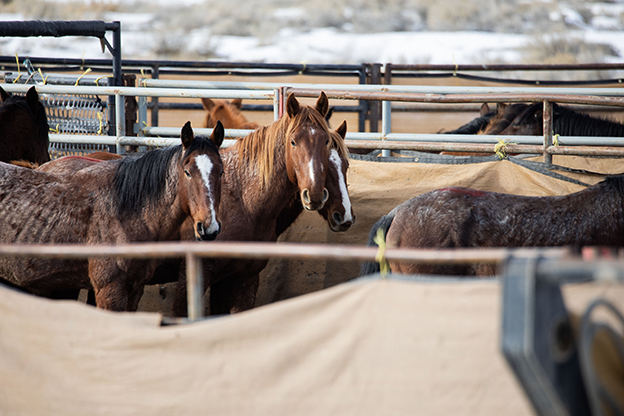
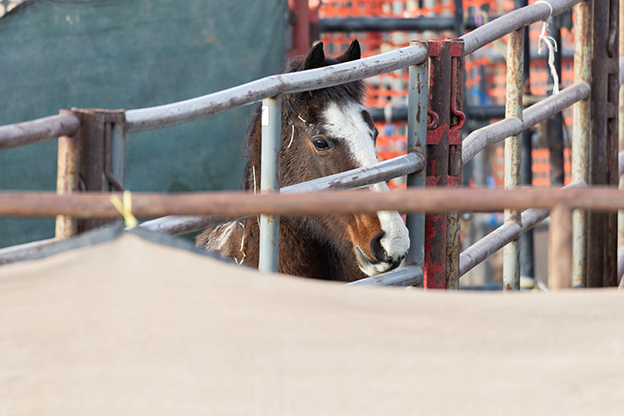
Photos of horses at temporary holding. BLM reports list an average body condition score of 2.5 to 3.5 for both the 6th and the 7th.
Date: January 06, 2024
Location: Same as the 1st, 2nd, and 4th (~25 miles East of Lovelock, NV)
Weather Conditions:
- High of 28° F
- Cloudy
Summary:
This is the fourth day of operations at this trap site. As on previous days, the observation point is over 2 miles away, but cloudy and cool temperatures reduced heat waves and provided more clear viewing than on previous days. Only small groups of horses were brought in today. During one of the runs, a mare and foal are both roped. At some point between entering the trap and the second half of the roping, the foal suffers a dislocation to his front, right knee. He is taken out of sight of the public on a UTV and euthanized. BLM has indicated that this will be the last day of operations at this trap site.
Total Captured Today (according to BLM Reports):
34 (14 stallions, 15 mares, 5 foals)
BLM euthanized two horses:
- 1 year old sorrel colt - dislocated front, right knee during roundup operations
- 20 year old sorrel stallion – blind in right eye
Observations and Events:
- 6:15 AM: Met with BLM on Coal Canyon Rd.
- It took ~45 minutes to caravan to observation
- This is the 4th day at the current trap site
- 8:20 AM: The pilot brings in two small groups
- 10:00 AM: A group of 7 splits and turns away from the trap site, but the pilot is still able to drive them into the trap
- The pilot herds a group of 3 into the trap
- 11:00 AM: The pilot navigates 5 horses towards the trap
- A mare and foal break through the jutes and leave the trap area at a run (see video 00:00–00:45)
o Wranglers head out to rope the mare and foal (video 00:46–1:05)
o The wranglers rope the mare (video 01:08), and shortly after rope the foal (video 01:12)
o The foal jumps into the air when roped and falls (video 01:15)
o The foal struggles against the wranglers, bucking numerous times (video 01:18–01:47)
o The foal goes down another time, but does not get up immediately (video 01:48–01:59)
o When the foal gets back up, it appears to be reluctant to bear weight on the front, right leg (video: 02:01–02:49)
o Contractors bring a UTV to the foal
o The foal is loaded on its side onto the UTV (video: 02:50–03:10)
o The foal’s head appears to still be moving as the UTV transports the foal out of sight (video: 03:47–end)
o The UTV comes back empty - BLM staff told AWHC’s onsite observer that the foal sustained a fractured knee from jumping through the jutes and that the foal was loaded onto a trailer and would be buried
- During the last run of the day, 2 horses are brought in
- The trap will be moved the next day
- BLM reports list Henneke body condition scores of 2.5 to 3.5
Temporary Holding:
Observers were given a brief tour in the afternoon before it began snowing. There are currently not very many horses at temporary holding.
A mare and foal escape the jutes lining the trap wings. Wranglers rope the mare and foal. The foal bucks and falls multiple times after being roped. He begins to limp after one of the falls. This foal was reported by the BLM to have been euthanized due to a dislocated front right knee. The exact timeline of events is summarized in the “Observations and Events” section
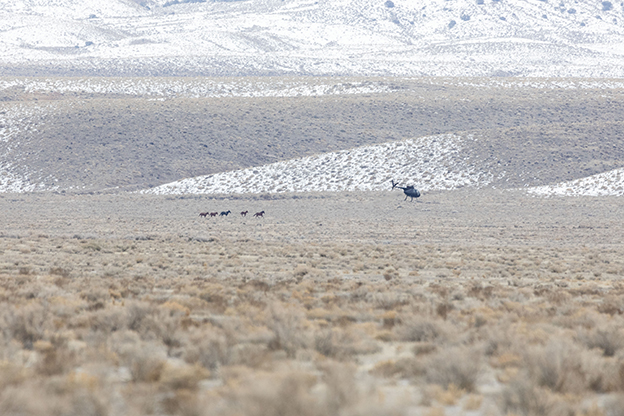
A helicopter navigating a group of horses towards the trap.
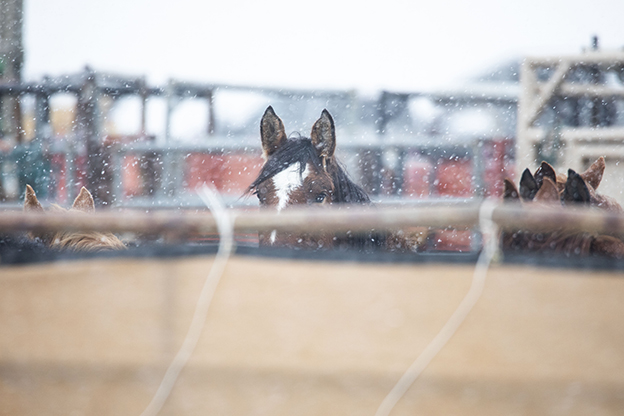
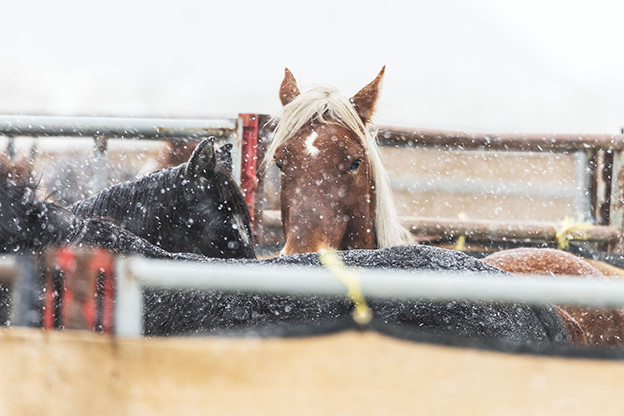
Snow falling at temporary holding.
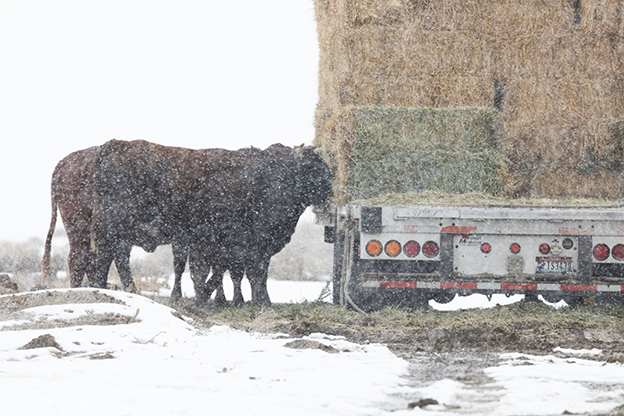
A group of cattle take advantage of hay on a trailer at temporary holding.
Date: January 05, 2024
Summary:
No operations. Observers waited from 7AM to 12:45 PM at the observation site after which they were escorted back to town. During the waiting period, the jutes had been set up and trailers and contractors were seen headed to the trap site, but there was no helicopter and no information on the reasons for the delay. The next day, observers were told that fog at the helicopter's location had prevented flight.
Date: January 04, 2024
Location: Same as the 1st & 2nd (~25 miles East of Lovelock, NV)
Weather Conditions:
- 23° F – 41° F
- Overcast
Summary:
There were 3 members of the public at today’s observation. As before, the trap site is over 2 miles from the observation point, making it difficult to record operations at the trap itself. Today’s runs felt more slowly paced than previous days with horses typically coming in at a trot rather than a canter. Operations ended early, allowing for a visit to temporary holding.
Total Captured Today (according to BLM Reports):
104 (47 stallions, 45 mares, 13 foals) (Note: numbers were corrected--original report had "46" listed for stallions).
BLM euthanized one horse:
- 7 year old bay stallion - previously broken right, front leg
Observations and Events:
- Horses were coming in at a trot more often than a run
- Horses on trailer loads to temporary holding appeared sweaty
- Some of the horses on the trailers had bloody faces
- 11:00 AM: 3 horses break off from the main group being driven by the helicopter
- The helicopter later targets this group, and one of the horses turns around several times to look at the helicopter
- Only 2 of the 3 horses enter the trap
- 2:45 PM: Operations end for the day
- The same trap location will be used tomorrow
- BLM reports body scores of today’s horses averaged between 2 and 4
Temporary Holding:
The nights of the 31st and 1st, over 200 horses were held at temporary holding based on BLM reports. At prior roundups, this would be expected to create overcrowded conditions. However, AWHC’s onsite observer had been unable to access temporary holding on those days. BLM staff indicated that holding is set up for a greater capacity of ~280 horses (120 mares, 120 stallions, and 40 foals). In stark contrast to the horses in pens, cattle freely wandered the grounds at temporary holding. There are several year-round grazing allotments overlapping HMAs and HAs in the East Pershing Complex.
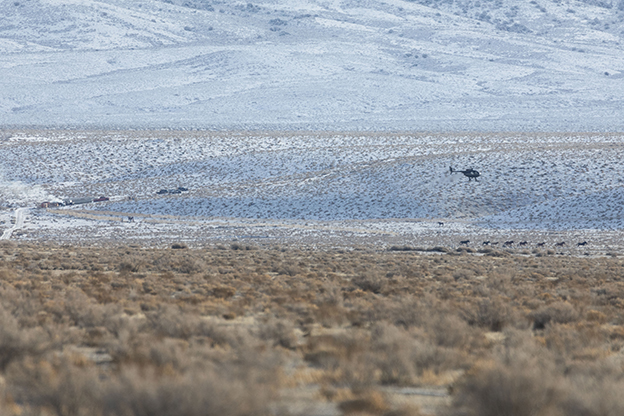
A helicopter navigates a group of horses towards the trap site. The trap can be seen on the left side of the image.
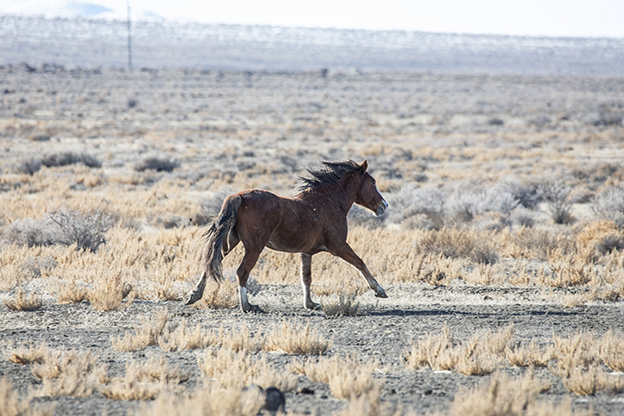
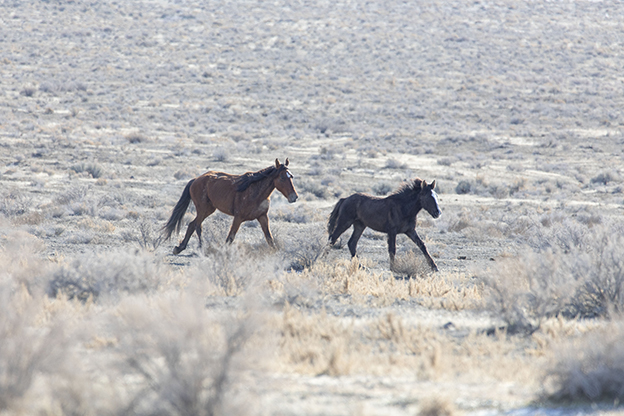
Three horses pass near the observation point. BLM reports body conditions of today’s horses range between 2 and 4.
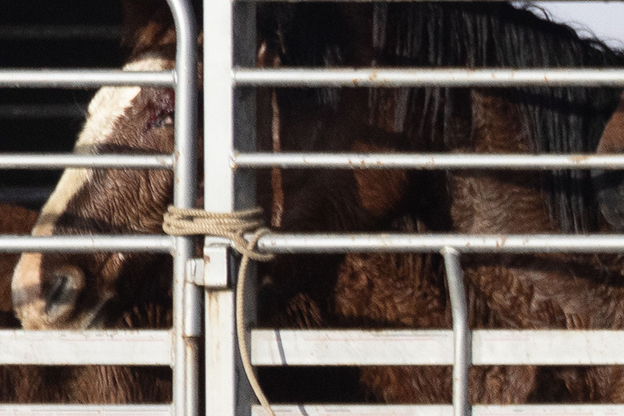
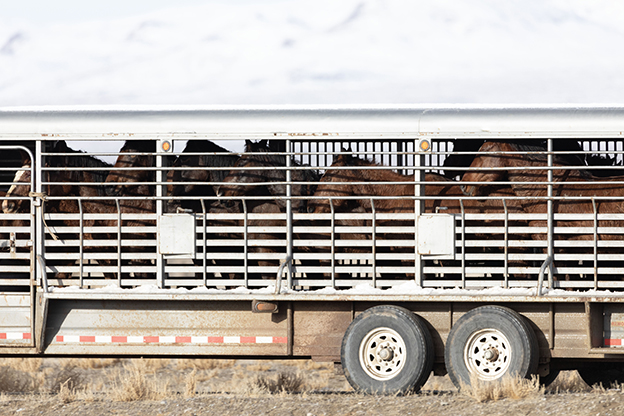
Sweating horses on trailers headed to temporary holding.
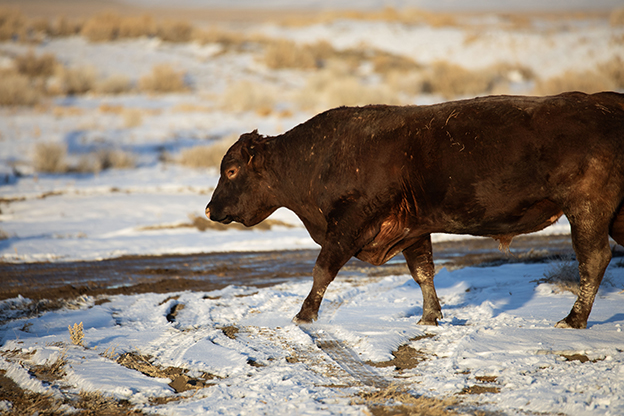
A bovine walking near temporary holding.
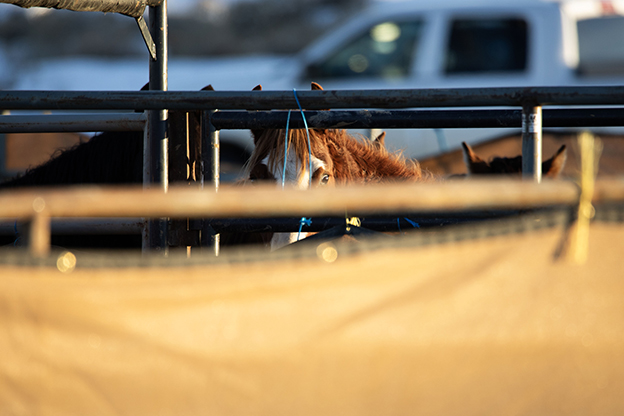
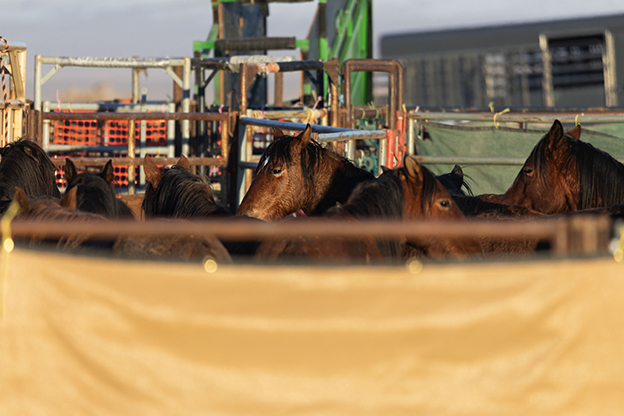
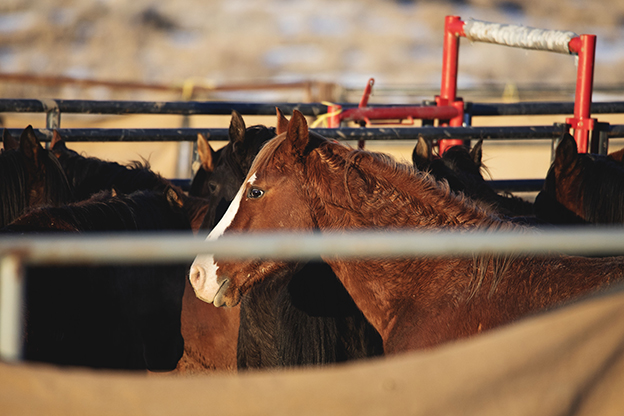
A selection of photos of horses at temporary holding.
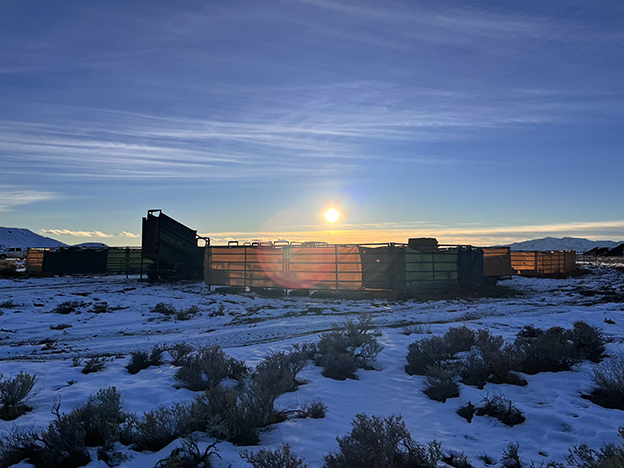
Temporary holding near sunset
Date: January 03, 2024
Summary:
The BLM daily report indicates there were no gather operations due to snowfall. Horses were shipped from temporary holding mid-day.
Date: January 02, 2024
Location: Same as the 1st (~25 miles East of Lovelock, NV)
Weather Conditions:
- 26° F – 44° F
- Overcast
Summary:
Despite it still being light after operations yesterday, AWHC has not been permitted to independently assess conditions at temporary holding for the last 3 days (since December 30th). Helicopter operations continued today at the same trap site as yesterday, with an observation site over 2 miles away from the trap. The distance inhibits visuals of trap operations and provides limited viewing of helicopters driving horses. Several groups >20 horses were brought in. Many groups were difficult for the pilot to navigate into the trap and some larger groups splintered into several smaller bands of horses.
Total Captured Today (according to BLM Reports):
128 (56 stallions, 58 mares, 14 foals)
Observations and Events:
- Trap site is over 2 miles away from the observation point
- Views are limited due to the distance
- 8:00 AM: Helicopter in the air
- A group of 20 horses is targeted and the helicopter spends the next 50 minutes trying to drive the group into the trap
- The pilot did not reduce the helicopter pressure until the horses were moving in the direction of the trap
- 8:57: The group from run 1 enters the trap
- Run two is a large group of 40-50 horses
- Some horses split off from the main group and it reduces to around 30 horses by the time they enter the trap
- 11:14 AM: A group of 30 horses is brought into the trap
- The next run, around 25 horses, required a significant amount of helicopter navigation before they entered the trap
- 3 PM: During runs 7 & 8, horses scattered away from the helicopter
- A foal drops behind the group several times, but catches up by the time the other horses in the group enter the trap
- BLM gather reports list an average body score of 3
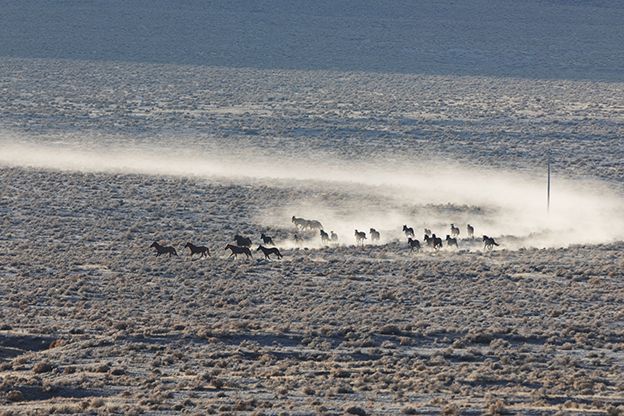
A group of horses makes a turn as they run from the helicopter, leaving a trail of dust along their path
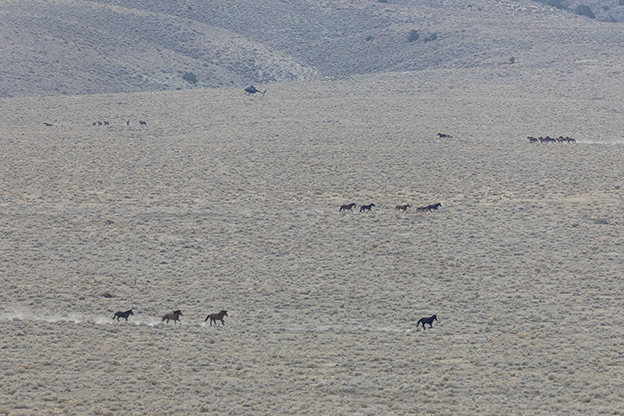
Scattered groups of horses around a helicopter
[Video Link]
A foal falls behind the group it is with. The group is able to pause, allowing for the foal to catch back up.
[Video Link]
Horses on trailers headed to temporary holding
Date: January 01, 2024
Location: ~25 miles East of Lovelock, NV
Weather Conditions:
- 22° F – 48° F
- Sunny
Summary:
The new trap site is located in a large valley and BLM chose an observation site ~2.5 miles away. Today’s operations got started late, with the helicopter not in the air until around 10 AM. There were a number of large groups of horses in the area, and groups brought in by helicopter were typically between 20 to 40 horses. The operation felt rushed. While the trap could not be seen due to the extensive distance between observation and trap site, earlier trap builds suggest that traps would have been crowded with the number of horses coming in. Loading horses onto trailers took up the majority of the afternoon.
Total Captured Today (according to BLM Reports):
152 (66 stallions, 66 mares, 20 foals)
Observations and Events:
- 7:30 AM: Met with the BLM
- ~10:00 AM: The helicopter takes flight
- The pilot did not have to travel far to find large groups of horses
- Most runs were on the order of 20 to 40 horses at any one time
- Due to the trap site’s distance, views of operations were poor and could not be independently assessed by the onsite viewer
- Based on trap setups on previous days, the onsite observer anticipates the trap was quickly very crowded
- Horses on trailers passing the observation site look sweaty, tired, and dusty
- One of the passing trailers had a smaller horse lying down which was unable to get up
- 1:30 PM: Helicopter flights stop
- The rest of the afternoon is spent loading and shipping horses
- AWHC had to remain onsite at observation until the final trailer left the trap
- 4:00 PM: Operations end for the day
- Observers were not given an opportunity to observe unloading
- Due to it being sunset at the end of operations, observers were unable to visit temporary holding
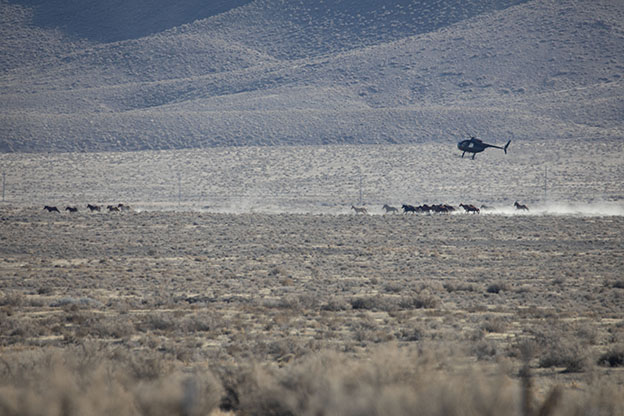
A helicopter pressures a group of horses towards the trap
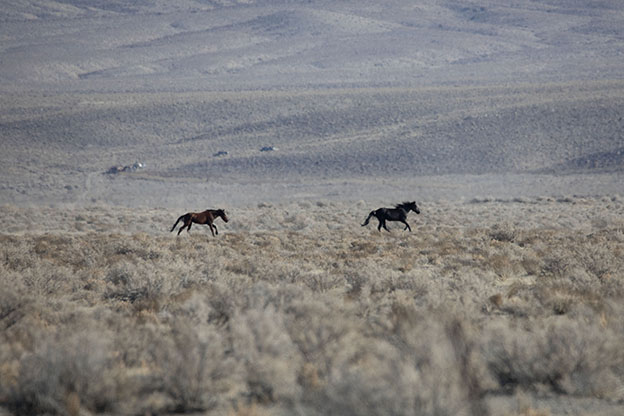
Two horses being pushed towards the trap site by helicopter.
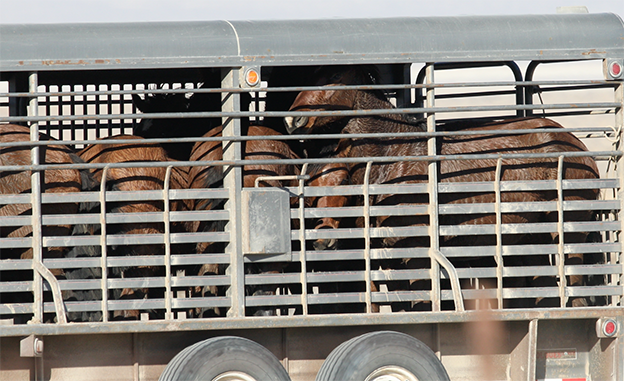
Sweating horses on a livestock trailer
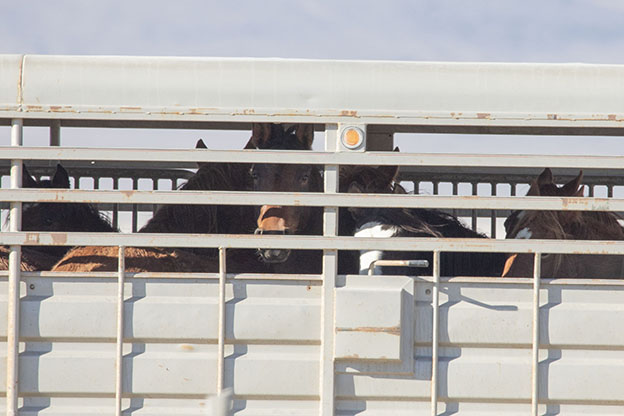
Another design of livestock trailer used to haul horses to temporary holding.
Date: December 31, 2023
Location: ~20 minutes from meeting location at Coal Canyon Rd., NV
Weather Conditions:
- 22° F – 44° F
- Sunny in the morning
- Partly cloudy in afternoon
Summary:
Today’s operations were at a new trap site located within the North Stillwater HMA. The viewing site was much closer than on previous days, offering a good view of the trap. Horses in today’s runs spent more time running and seemed in better condition than horses rounded up on previous days. Horses are coming from several miles away and are sweaty as they enter the trap. In the afternoon, one horse attempts to jump the panels and knocks over a foal in its panic.
Total Captured Today (according to BLM Reports):
129 (51 stallions, 61 mares, 17 foals)
4 horses were euthanized by the BLM due to chronic conditions:
- 16 year old bay stallion, blind in left eye
- 14 year old bay stallion, blind in right eye
- 14 year old bay mare, blind in left eye
- 20+ year old bay stallion, blind in left eye
Observations and Events:
- 7:30 AM: Met at Coal Canyon Rd and caravanned ~20 minutes to the new trap location
o The meeting time was later than previous mornings as the trap was moved this morning - The observation site was much closer (<0.5 mile away) with a good view of the trap
- The trap is located near debris from abandoned mining sites
- 8:20 AM: Helicopter is heard taking flight
- ~8:50 AM: A group of around ~35 horses, already sweaty and dusty, are seen being pushed by the helicopter
- The group split as they were closing in on the trap site
- 9:00 AM: The pilot focused on a group of ~11 from the split horses and they enter the trap
- 9:30 AM: Run 2, consisting of part of the scattered group in the first run
- 9:45 AM: Two trailer loads leave the trap
o Two horses are seen kicking and biting each other in a trailer - Run 3 is composed of ~20 horses
- Horses are spending more time galloping (running) than in previous days
o AWHC observer notes that these horses seem in better body condition with higher energy - Some horses from run 3 crash into panels and pile on each other
- 11:10 AM: Run 4, ~40 horses come in from an estimated 7 miles away
o The large group intermittently splits into multiple, smaller groups
o One horse in the group stumbles but gets back up and appears okay - ~12:00 PM: Horses from Run 4 all enter the trap
- A lot of pressure is used (shouting, flags, panels, and tarps) to get the horses to move forward into the trap
- 1:00 PM: Horses have been loaded onto trailers
- 12:40 PM: Another run of ~20 horses
o It takes over an hour to bring these horses into the trap
o One of the horses brought in crashes into panels 3 times
o In its panic, the horse slammed a foal into the ground and the panels
o The foal was able to get back up - 3:05 PM: Run 5, consisting of ~20 horses, enters the trap without issue
- Operations end for the day
- Body conditions of horses are listed as an average of 3 by the BLM
- It was too dark to visit temporary holding at the end of today’s operations
A view of the horses from run 4 being brought into the trap by helicopter
A panicked black horse tries unsuccessfully to jump the panels 3 times, knocking over a foal in the process
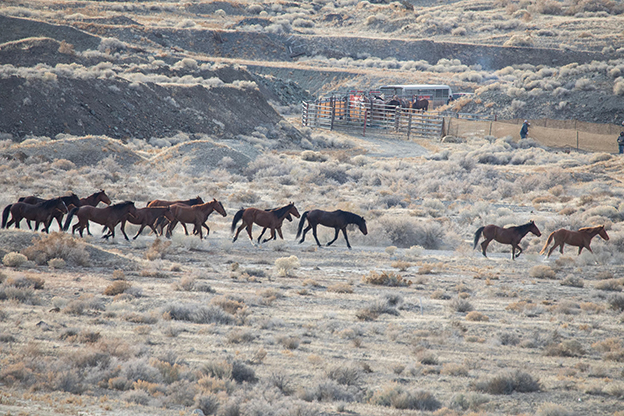
Today’s observation site was closer than on previous days and offered good views of the trap
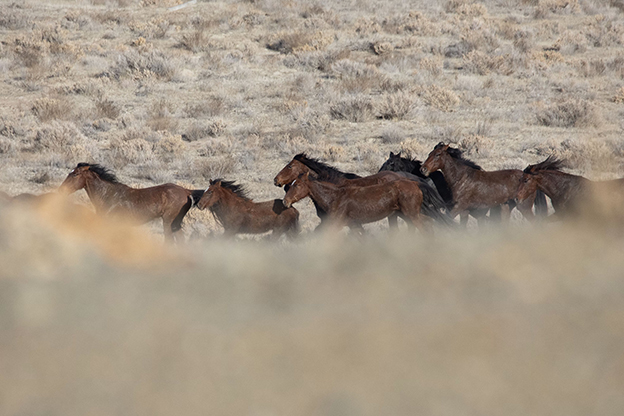
An example of sweat on horses brought into the trap
Date: December 30, 2023
Location: ~40 miles South-Southeast of Lovelock, NV
Weather Conditions:
- 34° F – 50° F
- Light breeze
- Partly cloudy
Summary:
Two members of the public were observing today, including AWHC. The observation site for the new trap is located over a mile away. While there is view of the wings, there is no view of the trap. There were a number of difficulties associated with this trap including horses being hesitant to enter the wings and escaping horses, leading to a number of wranglers roping adult horses. So far in this roundup, foals account for only 2% of the total horses captured. BLM suggests that this could be caused by a combination of mountain lions and a lack of resources (food, water) on the range.
Total Captured Today (according to BLM Reports):
140 (58 stallions, 81 mares, 1 foals)
2 horses were euthanized by the BLM due to injuries sustained in roundup operations:
• 4 year old bay mare, broken neck (unloading at temporary holding)
• 12 year old bay mare, broken left hind leg (at the trap)
Observations and Events:
- 6:00 AM: Met with BLM to caravan to the new trap site
o The new site is the furthest south that operations are expected to occur
o BLM states that the goal is to capture 200 horses from this location
o The site is ~45 minute drive from temporary holding, necessitating the use of large stock trailers that hold up to 35 horses - 7:30 AM: The pilot targets a few groups napping along the road, totaling ~45 horses
o Pilot utilized a lot of helicopter pressure (getting close to horses) as the horses were moving slowly
o The group of 45 horses hesitated at the trap site, stopping in the wings
o Half of the group split and ran back down the trap, nearly running over a contractor located in the wings - The helicopter and 3 wranglers attempt to push the escaped group back towards the trap
o They tried to turn horses around for an hour, but were unable to push them into the trap
o The horses were tired and breathing heavily - 10:30 AM: The next run comes in, with the biggest group of horses being pushed in one run so far
- A small group is brought in first
- The larger group is navigated to the trap after
- Several individual horses escaped and a few were roped and brought in
o Due to observation distance, roping of individual horses was difficult to see - 11:45 AM: A small group of horses is brought in
- A few of these horses escape the wings and slip and fall as the helicopter pushes them to make hard turns
- Two more runs followed
o As in prior runs, horses were hesitant to enter the trap and some horses escaped - 2:15 PM: Helicopter operations end for the day
- Body conditions of horses are listed as an average of 3 by the BLM
Temporary Holding
AWHC’s onsite observer visited temporary holding for a walk through right at sunset.
Horses in Run 1 moving slowly towards the trap site. Horses typically move at a canter (or run) during helicopter roundups.
Horses in Run 1 balk in the wings of the trap, then turn and leave the wings of the trap, nearly running into a contractor as they escape.
3 wranglers and a helicopter attempt to navigate the escaped horses from Run 1 back into the trap. They try for around an hour, but are unsuccessful.
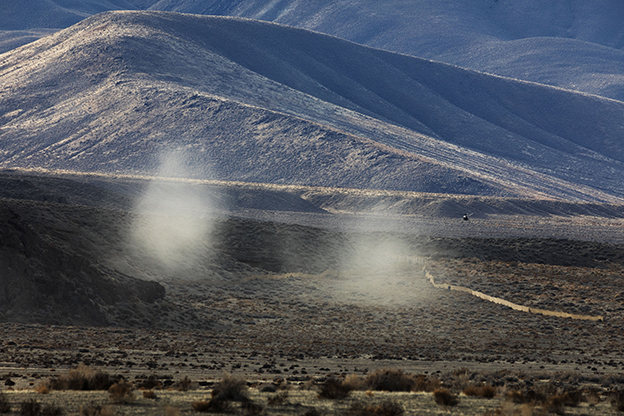
The camera’s view of the trap site from the observation point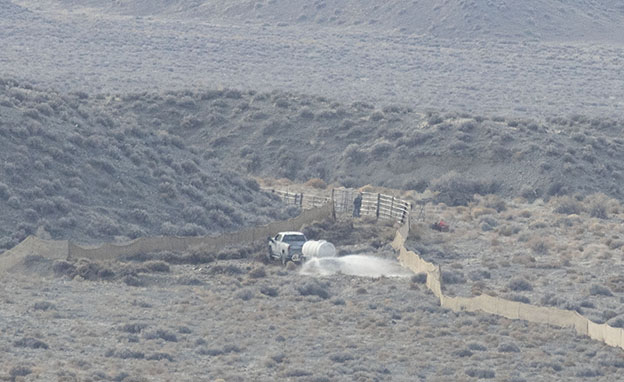
The wings of the trap are watered down to decrease dust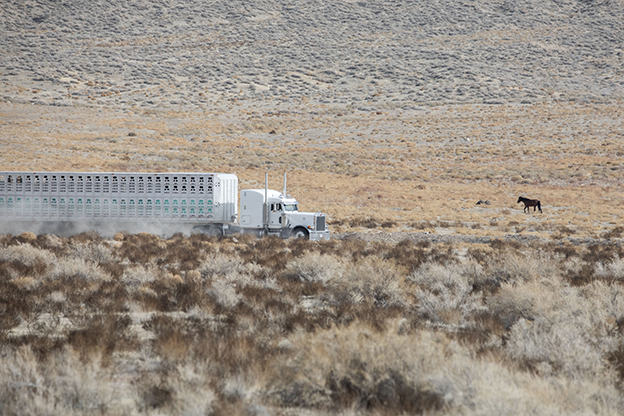
Large livestock semis that can hold as many as 35 horses. These were used today as temporary holding was an ~45 minute drive away
Date: December 29, 2023
Location: Same as the 28th (~30 miles Southeast of Lovelock, NV)
Weather Conditions:
- 30° F – 50° F
- No winds
- Mostly sunny
Summary:
There were 4 members of the public in attendance including AWHC. Two horses were euthanized in the morning—one with a club foot and one blind in one eye. Most horses captured are from outside of the North Stillwater HMA. Horses in today’s operations seemed to enter the trap without issue, though were hesitant to load onto trailers. The trap site will be moved further south tomorrow. Operations ended early enough that observers were given a tour of temporary holding.
Total Captured Today (according to BLM Reports):
42 (22 stallions, 20 mares, 0 foals)
2 horses were euthanized by the BLM:
- 10 year old bay stallion, blind in left eye
- 7 year old bay stallion, club foot on right front
Observations and Events:
- 6:00 AM: Met with BLM and caravanned ~1 hour to the same trap site as yesterday (the 28th)
- Dust on the roads are some of the worst AWHC’s observer has seen during roundups
- Run 1: ~3 horses
- Run 2: ~13 horses
- Horses coming in at a trot
- 9:50 AM: A band of 7 horses enters the trap from the East at a gallop
- 11:00 AM: A group of ~20 horse comes from the North
o The majority of the larger groups of horses are being gathered from the North - Horses loaded onto trailers appeared scared and took an extended period of time to load onto the trailer.
- The trap was moved further south for the next day’s operations.
Temporary Holding
On-site AWHC observers were given a tour of temporary holding after the horses were fed and watered. Tarps used in construction of temporary holding cannot be seen through. Horses can only be seen when they lift their heads over the panels. In general, the horses seemed settled with more commotion was heard from the mare pens.
In the morning, observers will be given an opportunity to watch the shipping of the horses. Observers will be able to watch from a flagged box at a certain distance away.
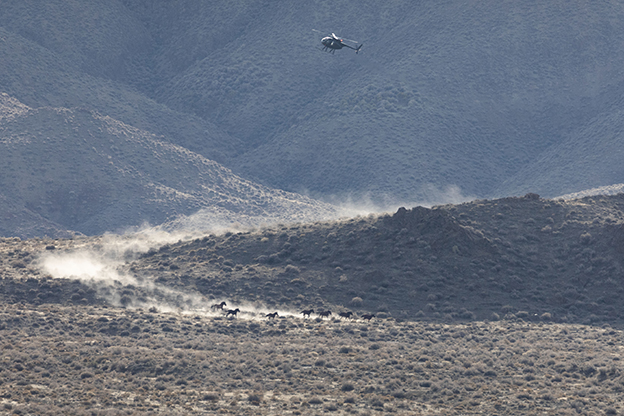
A group of horses galloping away from the pressure of the helicopter
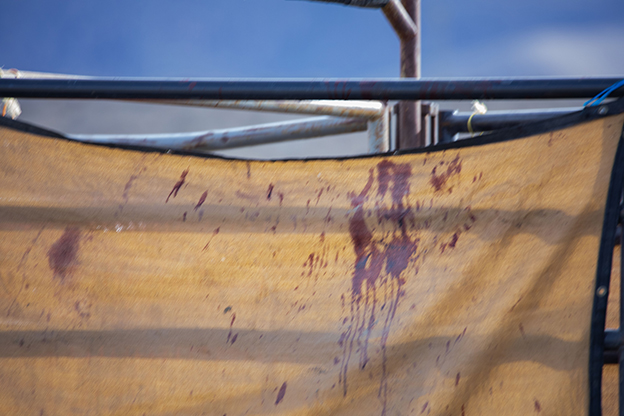
Blood stain on a tarp in the temporary holding unloading area
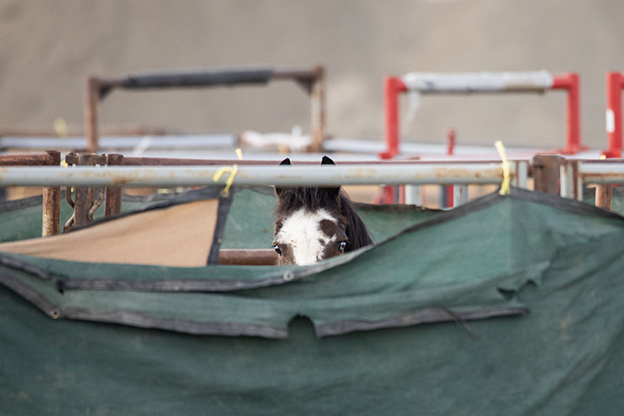
A horse with one blue eye peeks out from over the top of a solid tarp at temporary holding.
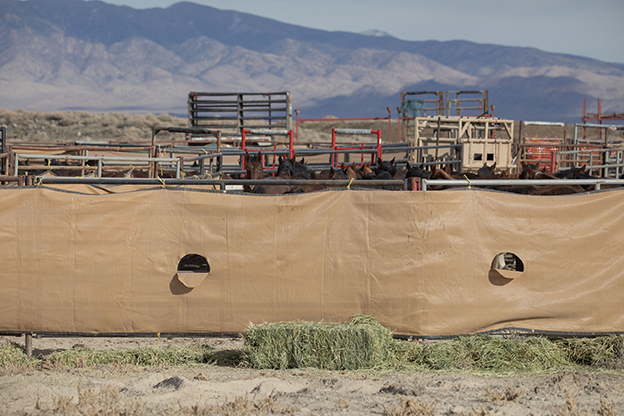
An example of a bale of hay fed to horses at temporary holding. Horses in a temporary pen can be seen behind.
Date: December 28, 2023
Location: ~30 miles Southeast of Lovelock, NV
Weather Conditions:
- 32° F – 55° F
Summary:
There were 10 members of the public in attendance including AWHC and KTVN 2 News. The observation site provided distanced views of the trap and loading, but the wings of the trap were obscured. No issues were observed during trap operations, but several adult horses broke away from larger groups and were roped. One band, not pursued by helicopters, wandered by the observation site during operations.
Total Captured Today (according to BLM Reports):
142 (63 stallions, 74 mares, 5 foals)
Observations and Events:
- Met with BLM north of Lovelock on Coal Canyon Rd.
- Drove east through Humboldt HA and then south to North Stillwater HMA
- BLM’s target for the area is around 200 horses
- Run 1: ~8 horses located near the trap site
- The helicopter’s pursuit of the horses was difficult
o Pilot navigated close to the horses in an attempt to re-orient them to the right direction
o Debris were kicked up next to the horses
o Tails of horses were affected by the wind of the helicopter’s rotary blade
o ~30 minutes to bring the majority of the group - 2 broke from the main group and were roped to be brought in
- Fights between horses observed within the trap
- Between Run 1 and 2, a band wandered by the observation site heading south.
- Horses rolled in dirt, rested, and appeared to watch the activity surrounding them
o Helicopter eventually targeted this group and brought them into the trap - 9:30 AM: ~30 horses brought in from the north over a period of 15 minutes
- 11:50 AM: ~45 horses brought in from the north at a trot over a period of 10 minutes
- 1:00 PM: A group of ~11 horses is brought in from the north
o 1 horse hung back, walking or standing
o Horse bucked/kicked out in response to dirt and debris kicked up by the helicopter - 1:20 PM: The group of 11 is enters the trap
- 3:00 PM: Around 30-40 horses making their way south to the trap at a trot.
o 1 horse broke away from the group and was roped - 3:35 PM: Horses in the group enter the trap
- Operations ended 20 minutes prior until sunset, preventing assessment of temporary holding
- The trap site will move tomorrow
- BLM reports the average Henneke body condition score was 3
[Insert video file here]
A band of horses wanders by the observation site. Behind them, roundup operations are ongoing at the trap.
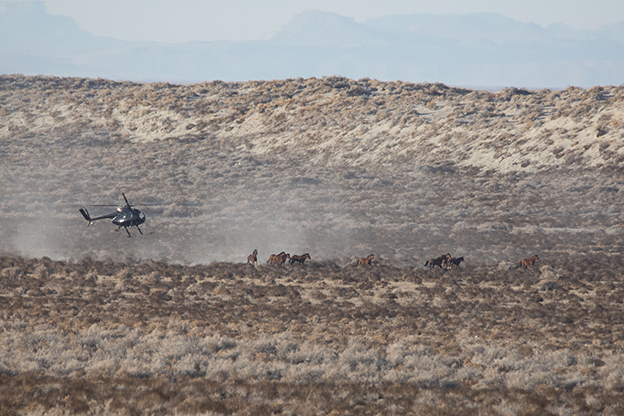
A helicopter driving a group of horses towards the trap.
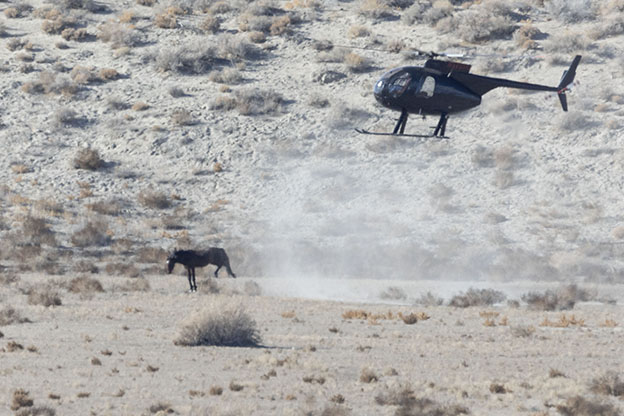
A horse, lagging behind a larger group, bucks after debris is kicked up behind him from rotating helicopter blades.
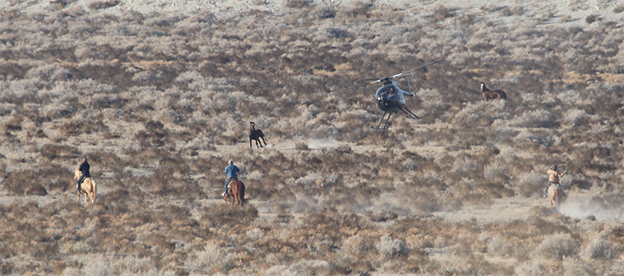
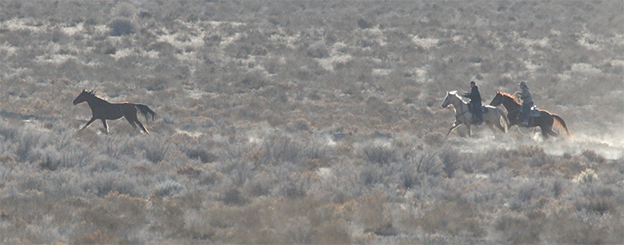
Adult horses which broke off from groups driven by helicoter are roped to be brought into the trap.


